#that wants to extend this comic to be a collaborative project
Explore tagged Tumblr posts
Text
Hello hello
ok so let me try being alive for once, idk why I went MIA... i mean i do but never mind that So, reblogging this because I wanted to let y'all know I've been not only THINKING but WRITING for this comic again and NO ONE is ready. Like I've had time to really polish this and I can't wait to get back to it. The thing is, I'm still in the process of trying to change jobs--the job I just got for the past year has been fruitful but exhausting, so I am in search of a job that has fewer hours and is either at walking distance or remote--so that I might have time to freely CREATE again. Not just doodles and renders here and there, I miss updating and posting on a weekly or sometimes daily basis. I want to be present as a creator so lemme get my foot in the door by saying it aloud!!




Heart Attack Part 1/? I've been thinking about this AU for years and since I've been avoiding starting yet another fic... I found a loophole and started a comic. HOWEVER, I have every intention to treat this comic as introductory. No way am I going to maintain my sanity if I have to finish this story, start-to-finish, as a fully-colored comic. Eventually, I'll close the comic at a good rest stop that doubles as a cliffhanger and that will be where the fic starts up from (or I'll write it from the beginning, using the comic as reference). If you like rivals to lovers, friends to lovers, "and they were roommates", and reverse lovesquare, then I hope you join me on the journey of sharing this fic <33
And here's a little video edit I made for it :D
youtube
EDIT: Also, sorry the last two pages are smaller, for some reason tumblr said they were too big?? when all the pages were roughly the same size???? anyway
#cass speaks#i actually sat myself down and wrote in a physical notebook for 2+ hours to plan out details of heart attack#not even plan actually they were already in my head i just needed to write them down before my mind burst at the seams from 'remembering'#this is after how ever many years of maladaptive daydreaming for scenes#i just hope i didnt disappear for so long that no one will care anymore#i hope someone likes it#oh and for anyone reading this first of all thank you and second of all if you're an artist you should know that there's a tiny part of me#that wants to extend this comic to be a collaborative project#mostly because i want to make sure it gets done and comics are a lot of work#but also it seems fun#but it'd only be artists bc the writing is 100% done#like i know the beginning to the end rn#and it's JUICY#anyway gn
477 notes
·
View notes
Text
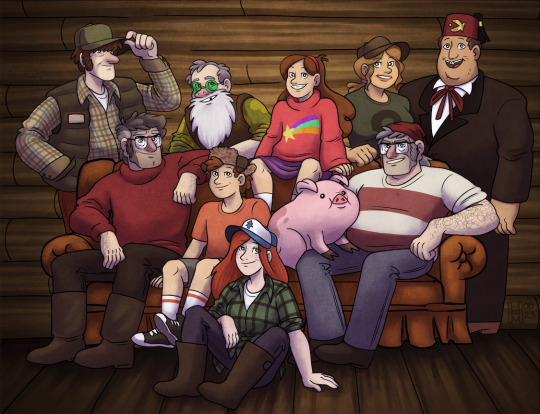
And here is the final piece I did for the "Trouble" Multi-artist Lyric Comic - a "polaroid" to end the final instrumental break of the song, in the video still to come!
Of course I wanted to show Stan and Ford's happy ending, surrounded by what I think of as the extended family they now have. (Or at least part of it! Not forgetting Dipper and Mabel's parents, and Shermie Pines and his wife, and so on. But this is, of course, the core extended family in Gravity Falls itself.)
This is also a good place to put some of the remarks on the project that I originally had in the big lyric comic post, but had to cut out just to get Tumblr to post that monster.
I really can't even begin to thank everyone who participated in this huge project! The result is, IMO, spectacular, and the process was a LOT of fun! I'm just so blown away with how everyone truly brought their A-game to whatever they did on the project. It was great to see the enthusiasm and creativity, and also to see folks really get into the idea of collaborating on how their take on their line fit in with those before and after them. And then, everyone contributing to the "polaroids" for the instrumental section was another case of seeing how much people got into the idea and collaborated, both in terms of suggestion, feedback, and actually teaming up (like some artists contributing to some of the great news-clippings that @fordtato came up with!).
Further: special shout-out to everyone; but, in particular to the folks who pitched in to do extra work in order to bring this to the finish line ( @stephreynaart, @fordtato @tazmiilly @gin-juice-tonic; and last-minute help from @creativepup and @nour386!). But even beyond that, every time extra help was needed we had a bunch of people volunteering; even if I didn't end up tapping everyone who stepped forward, I appreciated so much that I had so many people to depend on!
This turned out even better than I hoped it would when I first decided to try to make a project like this. And I am super excited to have a Stan Twins "vid" to this song, at last. (I've been wanting one ever since first hearing the song in 2016.) Stay tuned, of course, as @stariousfalls is working on finishing that video, and it will be out soon!
#gravity falls#stanford pines#stanley pines#mabel pines#dipper pines#soos ramirez#wendy corduroy#fiddleford mcgucket#melody ramirez#tate mcgucket#trouble lyric comic#fiddleford friday#sea grunks!#my art#id in alt
723 notes
·
View notes
Text
I'm a little late to the #webcomicday party but I still thought it'd be fun to break down my process a little bit using the latest Way Out chapter as an example!

So I have a rough outline for the whole comic but I don't go into too much detail planning each story arc until I'm about to get stuck into it. The rough outline is for jotting down ideas as they come along, acting as a skeleton for what will eventually happen, while the more detailed arc outlines are for plotting and pacing the story beats.
Planning each chapter out like this means that each one feels like its own mini-story, and more importantly, stays on track and achieves something to further the story or character progression. You'll notice that the chapter notes are still pretty barebones, which leaves me room to fine tune the smaller beats within the script.


Then, it's scripting time! I'll only have a script for the chapter I'm working on and a script for the next chapter, so as I'm currently working on Chapter 66 I have a script for chapter 66 & 67 but not 68. This is ideal for me in keeping the story flexible, allowing me to take a chapter in a bit of a different direction without feeling tied to a whole arc's worth of scripts that I'll need to rework otherwise.
Around 20 panels is the sweet spot for a chapter of Way Out; there are some with fewer and some with more, but shooting for that number makes me think about whether a scene ought to be extended or cut down in order to meet that goal. If I only plan out 18 panels then I can probably squeeze something extra in, while if I plan out 23 panels, I have a look and see if there isn't anything that can't be condensed.
The scripts themselves are pretty sparse, mostly just dialogue with basic action notes that I highlight as I finish. I'm usually pretty good with visualising things in my mind so the notes are more of a reminder to self about angles & expressions more than anything- if this were a collaborative project I'd probably put more effort into making it descriptive, but it's not.

I've never been one for thumbnailing, which is bad comic practice, I know. But once I have my script I just want to get stuck straight into drawing and don't like slowing down to jot down what is already pretty vivid in my head when I can just. draw the thing.
(a large part of why I started my first webcomic in the vertical format is because you don't need to consider variety in panelling and page flow, which is something thumbnails are very important for).
And so the sketching begins! My sketches are rarely pretty with little focus on anatomy and shape and more focus on blocking and size. I use Procreate to draw the panels and its resizing tool has a tendency to obliterate the quality, which I can sharpen in small amounts but it saves a lot of pain if I plan it all out in the ugly stage.
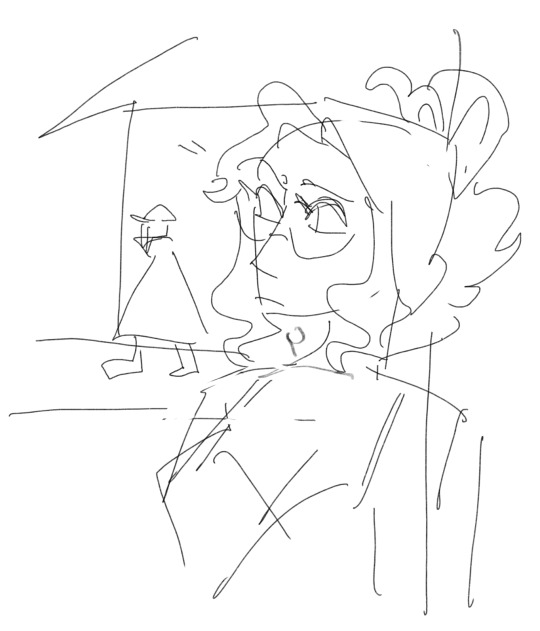
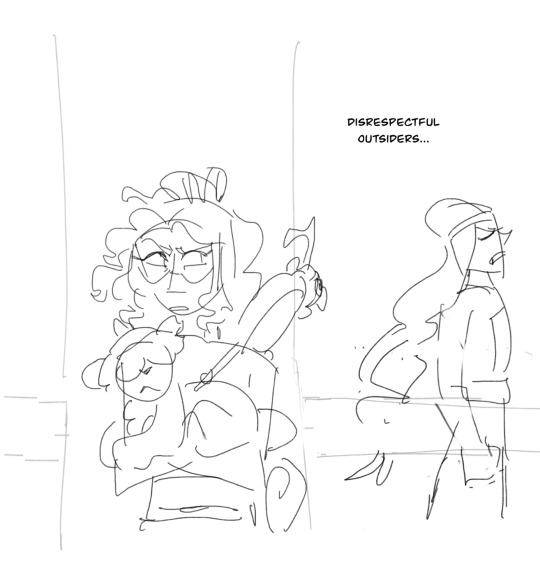
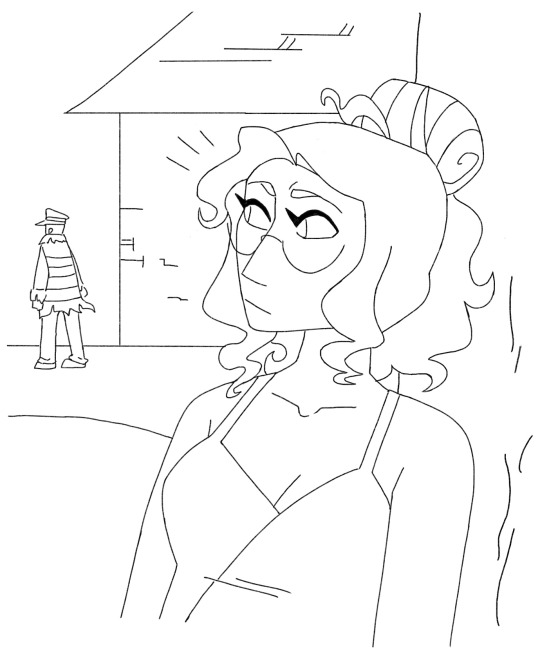
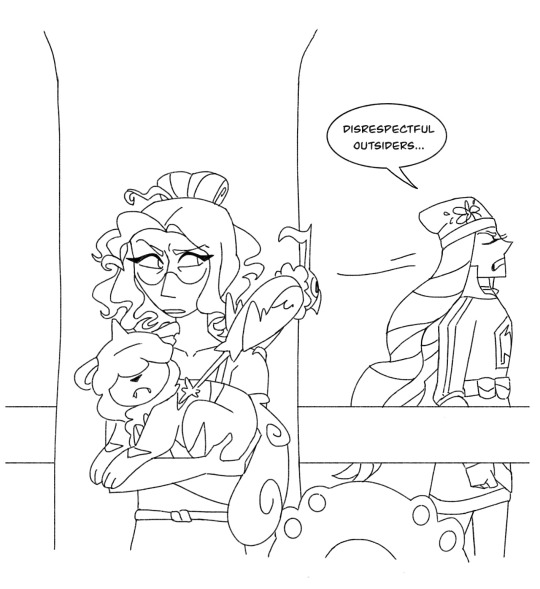
In some ways I often prefer the sketches to the clean lineart, but that's mostly the stylistic scratchy-ness of it that I have to do away with in favour of clean lines. I'm not always super proud of the art in the end but not every panel needs to be a masterpiece and it's all practice. I think a quantity over quality approach is kind of necessary if you want to make a comic and not lose your mind.
I sharpen up and clean any spots up as I go, but once they're all done I glue all the panels together on my desktop so that I can adjust the spacing between them, then I cut them back up again into smaller slices for posting! And that's the whole chapter process!
I also have a quick (and by quick I mean 4 minute) rough timelapse of chapter 65's coloured panel I can post, if anyone would be interested in seeing that, but it'll probably need to be its own post bc it'll crash this one.
10 notes
·
View notes
Note
As for the OC thing, I don't have an inherent problem with them existing (I mean, it's not like I don't have my own OC...), and I can even understand being mindful of wanting them to fully be their own person, as opposed to *just* something that Sonic influences. But of course, IDW has handled them very poorly, with most of them either being just plain shit (like Surge), or the ones who could have been great being ruined to the point of fatigue (like Tangle).
I got my own OCs, too. They're a lot of fun! I will finish their refs one day I just keep drawing dogs instead
I think Sonic as a series is very open to new characters. Unlike something that follows a completely linear story/timeline (like Xenoblade), it's incredibly easy to add someone new to the cast since Sonic is always traveling, looking for the next adventure and meeting new people. If a new character is introduced, it doesn't interrupt the overarching story since each one is relatively self-contained. You can hop in anywhere and that's something I love.
When you have a static character like Sonic who isn't going to have major development arcs, it makes sense to show how his positive attitude and heart of gold inspires others. The story isn't about following his personal growth; it's about how he touches the lives of others.
He helped give Tails confidence after he was bullied, he inspired Amy to become stronger so she could keep up with her hero, taught Blaze she didn't need to shoulder everything alone, showed Chip the world he never knew, and was there for Shahra when she was finally freed from her abusive boyfriend. It's not just Sonic either, this even extends to other characters, such as Amy reminding Shadow what he was created for.
I think that's actually a strong suit of the Sonic series and considering how large the cast is, I believe Sonic Team sees that, too. Which is why I'm missing it so bad in IDW.
Lots of the comic cast are just kinda there and that's okay, not everyone in the game cast is specially touched by Sonic, I mean the Babylon Rogues didn't exactly have a takeaway. Although, there hasn't really been anyone new that Sonic has had a personal impact on.
Tangle was a fighting adrenaline junkie already, Whisper opened up because of Tangle, Tails is just housing Belle and she finds closure on her own, Jewel is...I'll be honest I haven't quite figured that out yet, she really just exists.
Lanolin DOES get inspired to do more because of Sonic, but that's all off-screen and when she doubts herself, it's Tangle that picks her up — not Sonic. The closest I feel we've gotten to a character that Sonic has really affected is Surge and...yeah, she's her own bundle of problems.
I believe Surge and Kit were supposed to be Sonic's consequences — something to make him reflect on his mistakes and possibly take some responsibility for it, but it became condescending. It served for him to double-down on how he was right instead of acknowledging that his actions enabled their creation and continued to cause them pain.
I just saw projection. Surge spouting off about Sonic's holier-than-thou attitude, flinging the criticisms Flynn had gotten at Sonic and digging in his heels that he was right. (I know Stanley handled them after #51, although it appears the writing process is very much a collaborative one and she does try to mimic his style.)
There was nothing learned, nothing gained, no growth for anyone, the arc didn't matter, which is a problem the comic has suffered from before. I recognize it's a challenge with continuous stories, things happen because they're entertaining to read, but there really was no takeaway with any of it.
It's a shame because it'd be so easy to apply the obvious angle of getting close/succeeding in your goal doesn't fix the actual problem. The pain and anger doesn't go away, but now you don't have anywhere to direct it to. That's what I wanted to see with them, but of course, as Flynn said, this isn't something smarter.
#idw sonic#anti idw sonic#i don't know if you'd consider this an anti idw post but yeah#just gonna let people block it#sth#ask
32 notes
·
View notes
Text
Hand and Eye: Research
A History of Wordless Storytelling by David Wiesner
For this project’s research I decided to look at a more theoretical side of wordless storytelling. I found this article that goes through the history of wordless storytelling as well as some prominent examples.
- because it lacks words, it is the illustrator’s job to communicate through illustrations things that normally we rely on words to tell the reader about, such as the characters’ thoughts and emotions. Things such as body language and expression have to be taken into extra consideration as it can be an effective tool to transmitting emotion.
- The size of the image, the size of the character in the image, colour and lighting all can add to that as well.
- “Pages can vary between single-page pictures, double-page spreads, or pages divided into multiple images. Multi-image pages can extend or compress time; a single page of many panels can show scenes across long periods of time, or they can expand a single short moment in incremental detail. The sequencing of the various page layouts creates a visually engaging reading experience.” (Wiesner, 2021)
- In wordless storytelling the reader is nearly collaborating in the storytelling. This is because when words are absent, the story is more subjective, and each reader might interpret the story differently due to their lived experiences.
- Wordless stories can be found as early as cave paintings, greek and roman vase paintings, stained glass windows and tapestries.
- They did not rely most of the times on panels and separations, instead working with multiple images that work with each other that connect into a whole.
- “William Hogarth may be the only example of both a wordless and sequential storyteller in fine art until the 20th century. In 1731 Hogarth created a series of six paintings called A Harlot’s Progress in which the pictures are read in sequence from left to right. The images are dense with detail and must be examined closely to absorb all the nuances of the tale as the characters react to each other and to their surroundings.” (Wiesner, 2021)
- Wordless storytelling and sequential image making were the basis to what evolved into prominent types of storytelling nowadays, such as Manga, the modern comic strip and children’s picture books. “Picture Books” were a term used by Randolph Caldecott to describe his own work of children’s books, who was a pioneer in creating books where pictures were in every page and as important as the text that accompanies it.
- wordless storytelling is also the basis of moving picture, which started off as soundless due to technology not allowing for it. Similar to books, these early movies relied on sequential visual imagery to tell a story. This wave in turn inspired graphic artists to want to capture the movement in silent films in their own still art.
- While the start of comic strips did not involve words, wordless ones soon became rare - I wonder if this has to do with attention span, as I feel like wordless stories require more focus in order to interpret and enjoy.
https://www.carlemuseum.org/explore-art/story-board/louder-words-history-wordless-storytelling
Artist Focus: William Hogarth, A Harlot’s Progress

A Harlot’s progress Plate 1 (1732) https://www.metmuseum.org/art/collection/search/399540
https://www.thehistoryofart.org/william-hogarth/harlots-progress/
Analysis by thehsitoryofart.org:
- a series of 6 etched engravings that tell a story
- tells the story of Moll as she goes from being a proper lady to becoming a prostitute, and eventually dies from syphilis
- the release of this work came during a London attempt at cracking down prostitution
- Because it was engraved he managed to make copies of his work for sale, but he made it a limited release, which resulted in pirated copies. This resulted in an act of parliament where this piracy was illegalized.
- Plate 1: ”shows Molls arrival at the Bell Inn in Cheapside, London. Dressed simply in a plain white dress signifying her innocence and naivety, she is met by an old lady. The old lady is Elizabeth Needham, a notorious brothel keeper who specialised in procuring young virgins by deception. Moll believes she has come for legitimate employment, probably as a seamstress, but the despicable pox ridden Elizabeth has obviously fooled her.” “Among Molls luggage is a basket containing a dead goose, a present to a cousin, though this cousin may have been part of the ploy to lure her to London. Goose was a common slang word for a prostitute and here also represents her coming death in the final scene.” (Historyofart.org, 2023)
- Plate 2: “The other leading character is a wealthy Jewish merchant (see the Old Testament paintings in the background that confirm his religion). The mahogany table and various tea-related objects suggest his money has been made by trade from the British colonies. Moll's (...) dress is no longer modest and she now has the company of a West Indian serving-boy, a young female servant and an entertaining pet monkey, all lavish gifts from her doting master. (...) She deliberately pushes over a table to distract attention as a second, secret lover very furtively exits the room.” (Historyofart.org, 2023)
- Plate 3: “Moll’s new lifestyle which is prostitution is a satanic work; it is well represented in the art by the images of a broom and a hat hugged on the wall.” (Historyofart.org, 2023)
- Plate 4: “Moll is then arrested and taken to Bridewell prison with a slow but sure progression of untreated syphilis she had contracted earlier. On the fourth piece Moll Beats Hemp in Bridewell Prison the richly dressed Moll in a white heavy Cinderella gown with dotted face to suggest the advancement of the infection, is seen beating hemp with a mallet”(Historyofart.org, 2023)
- Plate 5: “Moll has just returned from prison and is dying of the illness denoted by the shroud-like blankets, wrapping her body. (...)Another woman believed to be the landlady is shown scuffling over Moll’s possessions. Moll's maid tries to stop the arguing and the looting.”(Historyofart.org, 2023)
- Plate 6: “he died in September 2nd 1731 as indicated on her coffin lid. Majority of the people around are her fellow prostitutes, they didn’t come to mourn but to take her belongings that remained. Moll’s son is very young and just plays around without any sense of understanding what’s going on.”(Historyofart.org, 2023)
Reflection:
While very hard to analyse it by myself due to lack of historical context, after reading this analysis it is easy to understand why Hogarth’s work was so praised. Beyond the main narrative, he uses background details that tell the story to an even further extent. One could superficially read the narrative as the Moll becoming a prostitute going to jail and dying, while someone with a more analytical glance will see, for example, that she is the mistress of a wealthy Jewish merchant (suggested by paintings in background), that he probably works in trade (seeing the furniture). Even further such as the views of the author on prostitution, alluding it to witchcraft with the broom and hat on the wall. Also looking at the background characters you can tell more about Moll’s life, how the other prostitutes did not particularly care for her as a person, and the maid’s loyalty who constantly is at her side including in her death bed, as she is seen to be the only person saddened by her death and upset over how people are acting at Moll’s wake. This work is an excellent example of how the background and every single detail can add another dimension to the wordless narrative, and I should keep in mind about using background to my advantage.I would love to use background to such an extent, however considering the time constraints of this project I do not think such ambitious work is possible.
Artist Focus: Fish is Fish, By Leo Lionni
https://www.nufs.ac.jp/media/3FishisFish.pdf

Pages 16 and 17 of Fish is Fish
This picture book by Leo Lionni tells the story of a fish and a frog, and the frog tells the fish stories about the outside world that the fish does not have access to. The fish then dreams of all these things, and curious, tries to leave the water, but nearly dies, finally learning to appreciate what he is and his underwater world.
Reflection:
While not wordless, I particularly liked this book’s style and thematically it links to my visual diary entries of my visit to the aquarium. He used a colouring pencil sttyle to draw everything, but he uses a variation of colour even on monotone things like underwater, which brings everything to life with its vibrancy. I particulary liked the decision the artist made of showing the things that the fish is dreaming about but never saw as derived from fish (as seen below), which is what he knows. It adds onto the isolated part the fish lives in, and adds immersion into the fish’s mind. It also makes his dreams look a lot more magical and fantastic.

While I cannot add many colours like he did, the textures and patterns he uses comes also to great effect in making everything more alive. The colouring pencil styles itself has a texture of its own that adds to the narrative, which is another reason why I am inclined to do my work in a pencil style, just like I experimented with in my visual diary. I also enjoyed the expressions he managed to give the fish simply by changing mouth shape, opening and closing it and eye direction. This adds character to the fish, and if I am to do a story about fish, this might be something I can take into consideration.
Relevant Source: Wordlessbooks.co.uk
This website is an archive of examples of only wordless books, which then you can have a glimpse into and the website’s writer’s opinion (Clare Walters). By searching this site I came across two books that caught my eyes:
- Wave by Suzy Lee (https://wordlessbooks.co.uk/books/wave):

In this book the colours are limited just like we have to limit ours, but this comes to great effect to distinguishing to what is sea and what isn’t. While everything looks like the same medium, the humans and birds are so carefuly depicted, while the waves look a lot more wild and explosive. This makes it seem like it could have been made by two different mediums, but instead it was just two different energies used with the same which gave expression to the sea. Everything seems dull and lifeless, but then the firl is playing in the sea, it all comes to life.
- Flashlight by Lizi Boyd: https://wordlessbooks.co.uk/books/flashlight

I greatly appreciated the smart use of colour in this book: where the flashlight touches, there is more colour, and everything that is in the dark is in the same two colour scheme. It adds to the wonder emotion the main character is feeling as he searches through the woods with his flashlight, and overall communicates this warm curiosity feeling. While again we are restricted in colour, where we choose to place it or limit it too can help further the communication of the narrative in general.
0 notes
Photo

‘Loki’ miniseries producer-lead writer-creator Michael Waldron chats about Marvel’s favourite troublemaker finally harnessing his true power and wit while at the behest of the Time Variance Authority
“Everyone has been asking ‘when are we going to see Loki’s real power?’,” starts Michael Waldron, as he animatedly dives into the upcoming Loki miniseries, starring Tom Hiddleston. “To have six episodes to explore his power has been so liberating because just from a ‘pure superhero abilities’ perspective, we wanted to explore the awesome stuff he can do, and also dramatically too.”
On board as Loki’s creator, executive producer and lead writer by Marvel Studios’ president Kevin Fiege, Waldron is itching for the series to drop already. It is evident as he gesticulates expressively as he puts forth how much Loki as a character means to him.
Last we saw the Norse trickster god, he had a giant purple hand wrapped around his neck. The shocking demise of Loki at the hands of the mighty Thanos in Avengers: Infinity War broke the hearts of millions everywhere. What would the Marvel Cinematic Universe (MCU) be without his quick-witted jests and pranks and devilish smile?
In 2019, the announcement of Loki, fans already speculated that it would take place in one of the Marvel Universe’s alternate timelines — and they were right. Dissecting and peeling back the layers of the multiverse has been “thrilling” for Waldron, director Kate Herron and the series cast and crew. “It’s a new sandbox, a new corner of the universe to play in. It was certainly a challenge to define the rules of these spaces, the Time Variance Authority and how these branching timelines work. It wasn’t just about going ‘anywhere’ it was about going ‘anywhen’.”
At the D23 Expo in 2019 when the project was first announced, Waldron called himself and Herron “custodians of the fans’ love for Loki.” Though he was not a comic-book reader growing up (he admits he came to truly know about Loki through the MCU), storytelling remains an utmost priority for Waldron, who almost reminds us that “this is television we’re doing.”
He continues, “We can pick our spots and slow down in a way a feature film never could, and we can do long and quieter dialogue scenes and build tension and emotion in the way best television has been doing.” But Waldron was keen on creating his own original storyline; taking existing elements from past Loki comics and existing TVA bits and putting his spin on them.
So far, the MCU has been extended into successful miniseries such as WandaVision, following Wanda Maximoff’s evolution into the Scarlett Witch, and The Falcon and the Winter Soldier, detailing Sam Wilson and Bucky Barnes’ partnership.
Loki meets bureaucracy
In the series, Loki is seen tumbling into the hands of the regulation-body Time Variance Authority, headed by Mobius (played by Owen Wilson). The best storytelling comes from an out-of-comfort-zone experience and seeing natural troublemaker Loki at the mercy of the TVA’s bureaucracy is sure to be a spectacle.
At this, Waldron chuckles, explaining that “it was a blast” to tip the scales for Loki while making room for his inevitable naughtiness, Waldron says, “It was a chance for our writers’ room to delve into some therapy, if they ever had to go to the DMV (U.S. Department of Motor Vehicles). While we were writing the show, I was in the process of getting a new passport. And you go back to work and go ‘ugh, you’ll never guess the bureaucratic red tape I have had to deal with! But we got excited, too, and were like ‘That’s the TVA!’ so we used that.”
This in mind, he continues, “Taking an organisation that is so soul-crushing by-the-book, so to speak, in their managing of time and dropping the most chaotic character in all of the MCU smack-dab in the middle of that is just amazing juxtaposition. It’s a great way to have both entities drive one another crazy, instigating a lot of amazing conflict right from the start.”
Waldron-Hiddleston-Wilson trifecta
Waldron — who has worked on notable projects such as Community, Rick and Morty, is writing for upcoming wrestling drama series Heels, and producing Doctor Strange in the Multiverse of Madness — has nothing but high praise for Hiddleston and his versatility as an actor and storyteller. It was integral that he pushes Hiddleston’s boundaries.
“That’s where the collaboration between writers and actors is such a joy...when you push one another,” he explains, “and my goal from day one was to tell a story of Loki that had never been told before. There had been 10 years of stories of this character and we hope folks would’ve seen a fully-realised redemptive arc. Now we are starting with this version of Loki at the end of the first Avengers film. So it was our responsibility to not retread old ground. Tom was more than game for that, in fact, he wanted to do that and go deeper into Loki’s shape-shifting identity.”
Probably one of the best surprises is Owen Wilson thrown into the mix. Known for being the early-2000s romantic-comedy must-cast, seeing him take on the meticulously attentive and seemingly diabolical Mobius will be a delight. So what about Wilson struck a chord with Waldron? “I am the perfect age [33] to have grown up with Owen Wilson in Wedding Crashers, Zoolander and Armageddon. I love Owen and he is so great in this show.”
Waldron elaborates on how Wilson and Hiddleston bring varying energies to the show. “Loki is proper and pompous, Owen is folksy and down-to-earth – so right away, energies clash in a way that’s harmonious. But what he shares with Tom is a hard-to-even-put-into-words unique charisma. They [Owen and Hiddleston] both have natural comedic abilities and they can have a purely dramatic conversation and they could play off one another’s energies and make certain the right moments funny and right moments dramatic. I didn’t even have to set up punchlines to get laughs in this show!”
253 notes
·
View notes
Text
‘Loki’ doesn’t just explore ‘anywhere’, but also ‘anywhen’: creator Michael Waldron

‘Loki’ miniseries producer-lead writer-creator Michael Waldron chats about Marvel’s favourite troublemaker finally harnessing his true power and wit while at the behest of the Time Variance Authority
“Everyone has been asking ‘when are we going to see Loki’s real power?’,” starts Michael Waldron, as he animatedly dives into the upcoming Loki miniseries, starring Tom Hiddleston. “To have six episodes to explore his power has been so liberating because just from a ‘pure superhero abilities’ perspective, we wanted to explore the awesome stuff he can do, and also dramatically too.”
On board as Loki’s creator, executive producer and lead writer by Marvel Studios’ president Kevin Fiege, Waldron is itching for the series to drop already. It is evident as he gesticulates expressively as he puts forth how much Loki as a character means to him.
Last we saw the Norse trickster god, he had a giant purple hand wrapped around his neck. The shocking demise of Loki at the hands of the mighty Thanos in Avengers: Infinity War broke the hearts of millions everywhere. What would the Marvel Cinematic Universe (MCU) be without his quick-witted jests and pranks and devilish smile?
In 2019, the announcement of Loki, fans already speculated that it would take place in one of the Marvel Universe’s alternate timelines — and they were right. Dissecting and peeling back the layers of the multiverse has been “thrilling” for Waldron, director Kate Herron and the series cast and crew. “It’s a new sandbox, a new corner of the universe to play in. It was certainly a challenge to define the rules of these spaces, the Time Variance Authority and how these branching timelines work. It wasn’t just about going ‘anywhere’ it was about going ‘anywhen’.”
At the D23 Expo in 2019 when the project was first announced, Waldron called himself and Herron “custodians of the fans’ love for Loki.” Though he was not a comic-book reader growing up (he admits he came to truly know about Loki through the MCU), storytelling remains an utmost priority for Waldron, who almost reminds us that “this is television we’re doing.”
He continues, “We can pick our spots and slow down in a way a feature film never could, and we can do long and quieter dialogue scenes and build tension and emotion in the way best television has been doing.” But Waldron was keen on creating his own original storyline; taking existing elements from past Loki comics and existing TVA bits and putting his spin on them.
So far, the MCU has been extended into successful miniseries such as WandaVision, following Wanda Maximoff’s evolution into the Scarlett Witch, and The Falcon and the Winter Soldier, detailing Sam Wilson and Bucky Barnes’ partnership.
Loki meets bureaucracy
In the series, Loki is seen tumbling into the hands of the regulation-body Time Variance Authority, headed by Mobius (played by Owen Wilson). The best storytelling comes from an out-of-comfort-zone experience and seeing natural troublemaker Loki at the mercy of the TVA’s bureaucracy is sure to be a spectacle.
At this, Waldron chuckles, explaining that “it was a blast” to tip the scales for Loki while making room for his inevitable naughtiness, Waldron says, “It was a chance for our writers’ room to delve into some therapy, if they ever had to go to the DMV (U.S. Department of Motor Vehicles). While we were writing the show, I was in the process of getting a new passport. And you go back to work and go ‘ugh, you’ll never guess the bureaucratic red tape I have had to deal with! But we got excited, too, and were like ‘That’s the TVA!’ so we used that.”
This in mind, he continues, “Taking an organisation that is so soul-crushing by-the-book, so to speak, in their managing of time and dropping the most chaotic character in all of the MCU smack-dab in the middle of that is just amazing juxtaposition. It’s a great way to have both entities drive one another crazy, instigating a lot of amazing conflict right from the start.”
Waldron-Hiddleston-Wilson trifecta
Waldron — who has worked on notable projects such as Community, Rick and Morty, is writing for upcoming wrestling drama series Heels, and producing Doctor Strange in the Multiverse of Madness — has nothing but high praise for Hiddleston and his versatility as an actor and storyteller. It was integral that he pushes Hiddleston’s boundaries.

“That’s where the collaboration between writers and actors is such a joy…when you push one another,” he explains, “and my goal from day one was to tell a story of Loki that had never been told before. There had been 10 years of stories of this character and we hope folks would’ve seen a fully-realised redemptive arc. Now we are starting with this version of Loki at the end of the first Avengers film. So it was our responsibility to not retread old ground. Tom was more than game for that, in fact, he wanted to do that and go deeper into Loki’s shape-shifting identity.”
Probably one of the best surprises is Owen Wilson thrown into the mix. Known for being the early-2000s romantic-comedy must-cast, seeing him take on the meticulously attentive and seemingly diabolical Mobius will be a delight. So what about Wilson struck a chord with Waldron? “I am the perfect age [33] to have grown up with Owen Wilson in Wedding Crashers, Zoolander and Armageddon. I love Owen and he is so great in this show.”
Waldron elaborates on how Wilson and Hiddleston bring varying energies to the show. “Loki is proper and pompous, Owen is folksy and down-to-earth – so right away, energies clash in a way that’s harmonious. But what he shares with Tom is a hard-to-even-put-into-words unique charisma. They [Owen and Hiddleston] both have natural comedic abilities and they can have a purely dramatic conversation and they could play off one another’s energies and make certain the right moments funny and right moments dramatic. I didn’t even have to set up punchlines to get laughs in this show!”
123 notes
·
View notes
Link
There’s a moment that every child who aspires to movie stardom dreams about. They practise it in front of the mirror: graciously thanking their parents, their first drama teacher, their favourite hamster; smiling; waving; trying valiantly to cry. No, it’s not an Oscar’s acceptance speech – at least, not anymore; it’s the moment that super-producer Kevin Feige offers you his hand across a conference table and tells you you’ve landed a Marvel movie.
Yesterday came the first reports that Olivia Colman is in talks to slip into full-body lycra and join the MCU, via the studio’s next small-screen series Secret Invasion. The news follows a recent clutch of arrivals of actresses of a similar age and calibre to Colman to other Marvel projects, including Kathryn Hahn’s show-stealing turn in WandaVision, and Julia Louis-Dreyfus’ surprise appearance in The Falcon and the Winter Soldier.
Such casting choices may once have sounded insane. Why would the woman who just two years ago won an Academy Award for her grief-stricken, crumbling performance as Queen Anne in The Favourite, and who is up for another one this weekend for The Father, choose to submerge her pristine brand as the reigning monarch of British acting, both on-screen and off-, in a barrel of brightly-coloured, pop-sountracked, quippy-scripted comic bookery?
Secret Invasion sounds even more deranged than the average Marvel project: it will likely focus on the race of green, reptilian aliens called Skrulls (Ben Mendelsohn will reprise his role as Skrull commander Talos from Captain Marvel), as they invade earth by shapeshifting to imitate superheroes. Colman as an alien reptile? It’s hard to think of a more unlikely piece of casting since Judi Dench dressed up in a catsuit.
But over the last decade, a foundational piece of Marvel’s strategy has been signing-on not just fresh-faced stars like Chris Evans and Tom Holland, but some of the world’s most serious performers: inde darlings (Mark Ruffalo, Tilda Swinton, Brie Larson), BBC-drama-grown Brits (Tom Hiddleston, Benedict Cumberbatch) and awards-laden powerhouses (Annette Bening, Scarlett Johansson, and even Anthony Hopkins, Colman’s co-star in The Father, who is also up for an Oscar) have all rocked up in the MCU. Much as the Harry Potter franchise once was, the films have become a who’s who of Oscar after-party invite lists.
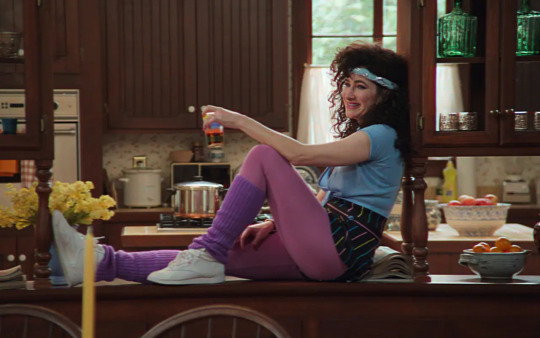
So why would the great and good of Hollywood acting willingly attach themselves to a franchise that one of the greatest directors of all time not so long ago declared to bear a greater resemblance to theme park rides than cinema? Marvel films are delightful but they are also frequently silly (inevitably, in the transition from cartoon comic book drawings to full-sized, three-dimensional adults leaping around on-camera dressed in skin-tight lycra suits and capes, some space for ridicule is opened up).
The studio is fully aware of this, which is why these films are comedies, but that does not make them any more obvious as vehicles for artists interested in rendering psychological depth on-screen. In 2012, Kiwi wunderkind director Taika Watiti told Interview magazine that he was suspicious of the way feature films can often “turn into commodities”. Yet five years later, his own Marvel movie, Thor: Ragnarok, hit cinemas.
The financial incentives to any actor are obvious and no doubt play a part but there is something even more valuable to someone like Benedict Cumberbatch – not exactly strapped-for-cash following Sherlock, The Imitation Game, and The Hobbit films – inextricably wound-up with those mega pay packages. That something is audience size. Avengers: Endgame, the highest-grossing film of all time until Avatar’s re-release in China in March last year, took $357 million at the domestic box office on its opening weekend.
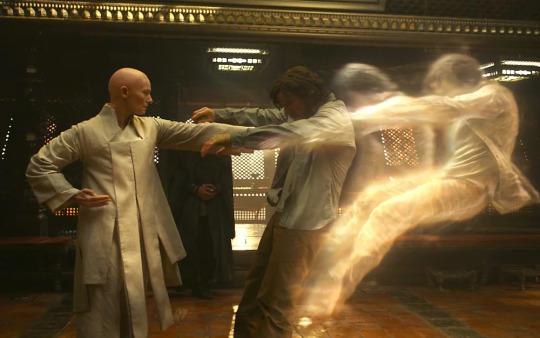
In America, the average price of a cinema ticket that year was about $9 – that means, by the roughest of calculations, that within 48 hours of the film’s release, 12% of the population, or some 40 million people, had seen the film. An actress like Colman has not exactly been confined to niche audiences – The Crown is not a small show – but even so, the prospect of such unparalleled exposure must be seductive.
The dream of a Marvel movie has not replaced the dream of an Oscar – it all but guarantees it. A symbiotic relationship is emerging between the franchise and the Academy, as the popular reach of one feeds and is elevated by the prestige of the other. There is no better example of this than the tragically-curtailed career of the late Chadwick Boseman.
From a handful of critically-lauded but quietly received biopics (42, Get on Up), he was propelled overnight to global stardom by his MCU roles as Black Panther, Marvel’s first black superhero, culminating in the Black Panther film in 2018. Now, just months after his death from cancer, he is a shoo-in to win a Best Actor award this week for his role in Ma Rainey’s Black Bottom. The opposite of a Marvel film in almost every sense – it’s claustrophobic, literary (it’s based on an August Wilson play), and tragic – it was Black Panther nonetheless that secured him the part.
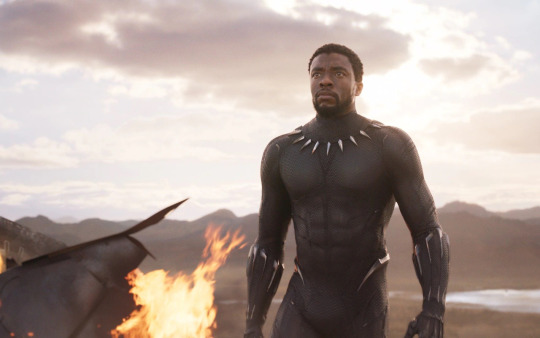
This give-and-take between superhero flicks and prestige dramas extends beyond actors: Watiti, who has just wrapped shooting on another Thor film, was nominated for an Oscar in 2019 for his German Resistance drama Jojo Rabbit, while Chloé Zhao, who is sure to win Best Director this weekend for Nomadland, has just wrapped her own Marvel movie, Eternals, which is slated for release in November.
Kathryn Hahn, meanwhile, was brought into WandaVision by director Matt Shakman, better known for directing prestige shows like Mad Men and Succession. His vision, in collaboration with the writer Jac Schaeffer, led to a formally wildly innovative show, providing the opportunity for Hahn and the show’s pair of stars Elizabeth Olsen and Paul Bettany – both outstanding actors – to flex their comic and creative muscles. Such starpower behind the camera is itself an attraction for actors of Colman’s calibre, and while there is as yet no word on who will direct Secret Invasion, there are many exciting possible names in the mix.
A few powerhouse industry figures were instrumental in fostering this mutually-beneficial relationship. The first was Robert Downey Jr, the original posterboy of the franchise. When he agreed to star in the first film, 2008’s Iron Man, it was a huge gamble – director Jon Favreau had to battle the studio to accept him – as he emerged from a wilderness decade marred by drug addiction, but it was also a huge coup. Downey Jr had just been nominated for an Oscar for Ben Stiller’s comedy Tropic Thunder and had recently starred in David Fincher’s instant cult-classic Zodiac; his personal reputation may have been in tatters, but as a serious actor, he brought chops.
His Iron Man would become the emotional and dramatic heart of the franchise over its next three phases. Kenneth Branagh, who directed the 2011 film Thor, also bridged the gap between the big flashy studio and his own thespy circle: he brought his protégé Tom Hiddleston, who at that point was best known for his British TV and theatre work, onboard to play Loki, a decision that Feige apparently described as the most important the studio would ever make. Hiddleston capitalised on rather than abandoned his roots: he approached the character like “a comic book version of Edmund in King Lear, but nastier.” It paid off: Hiddleston is a global superstar, frequently touted as the next James Bond, and his dedicated Loki spin-off show is the Marvel TV release of the summer.
Of course, there’s one thing that Marvel offers its actors that money simply can’t buy: a bit of fun. “If my actors aren’t having a good time on set, then I’m doing something wrong,” Waititi told Polygon in 2016. Reflecting on her playfully heightened performance in the early episodes of WandaVision in a recent interview with the New York Times, Hahn said that her husband said her performance had reminded him of her younger self in her college days. “I haven’t seen that part of you in so long – just you, hamboning it,” he told her. Colman, who is by all accounts is a mischievous on a film set, may simply want to bust out of those period costumes, slip into a bodysuit, and have a good time.
#Olivia Colman#Tom Hiddleston#Kathryn Hahn#Elizabeth Olsen#Paul Bettany#Robert Downey Jr.#Mark Ruffalo#Scarlett Johansson#Taika Waititi#Chris Evans#julia louis-dreyfus#Chadwick Boseman#Anthony Hopkins#Benedict Cumberbatch#Tilda Swinton#Brie Larson#Chloe Zhao#Ben Mendelsohn#Annette Bening#MCU#Kevin Feige
99 notes
·
View notes
Text
[S] Cascade After the Death of Flash
Most of us familiar with Homestuck are familiar with [S] Cascade. This seminal flash animation concludes Homestuck’s fifth act and is still considered by many fans the most important, climactic animation in the comic (even ahead of its successors [S] GAME OVER and [S] Collide).
Many of us may also be familiar with the extraordinary circumstances of the animation’s release. A user called Vivi on the now-defunct MSPA Forums made a commemorative comic documenting the occasion, which, to my view, really captures the essence of the release-mythos. In short: On October 25th, 2011, Homestuck updated after a year-long hiatus with a thirteen-minute flash called [S] Cascade. As fans raced to watch it, the influx of pageviews crashed Newgrounds, the site where the flash was hosted. Hussie temporarily uploaded the flash to megaupload.com. Megaupload.com crashed. The Homestuck website crashed; the Homestuck forum crashed; livestream.com crashed as fans who had “gotten in” tried to stream the video; and, finally, the Homestuck fandom crashed Twitter. [1]
Today, it is hard to imagine Homestuck fans crashing Twitter. Back in 2011, Twitter was a lot smaller, and Homestuck was a lot bigger. But it wasn’t just the long year of building anticipation and the mad scramble to watch the flash which cemented [S] Cascade as one of Homestuck’s most iconic pages. The Flash itself is aesthetically ambitious beyond any previous flash in the comic [2]. Not only does it combine detailed illustrations contributed by fan collaborators with an absolutely fire soundtrack; it manipulates the traditional Homestuck “panel” in a completely unique way.
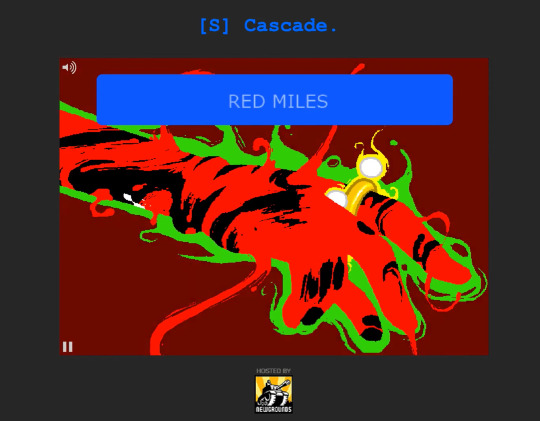
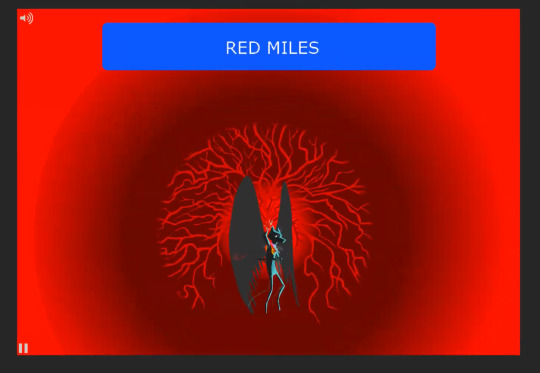
Among the various stunning moments in the flash, I find Bec Noir’s dramatic release of the red miles one of the most memorable. The YouTuber Precision F-Strike captures my same reaction when I watched [S] Cascade for the first time in this video around 1:20, exclaiming: “My screen is getting bigger! My screen is getting bigger!!” What made this “expanding panel” trick so dazzling upon my first watch? The release of the red miles marks the first instance in which [S] Cascade modifies the traditional size of the Homestuck panel. By no means does it mark the first time the comic as a whole has deviated from its own standard panel size; elongated panels, multiple panels, and links-to-panels have all been regular features of the comic up to this point. However, [S] Cascade is the first page to modify the panel size during a Flash sequence, changing in motion. This novelty, combined with the surprise of the effect, sets the reader up to expect a flash of epic proportions—and [S] Cascade delivers.
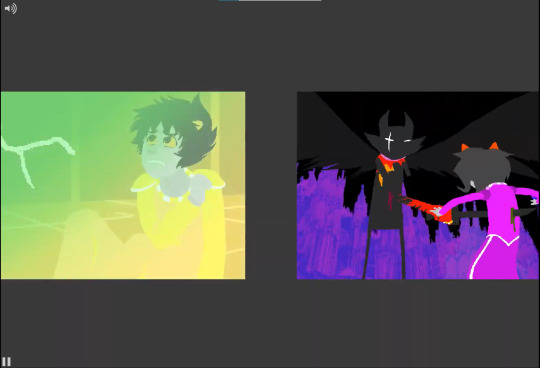
After expanding for the red miles, the panel never quite shrinks down to its original size. For the rest of the animation, the plot unfolds within an extended panel-space ripe for dramatic exploitation. At 2:53 the panel shrinks back down to show Bec Noir’s journey to post-reckoning earth, then grows again to get back into the action. At 4:22 it shrinks and breaks into multiple panels to illustrate Bec Noir wreaking destruction in the troll’s session. The proliferation of these moving rectangles mimics a film reel, reminding us that we have technically already seen these events, but underscoring their importance as a conglomeration of memories for the trolls.


Transitioning to the human sessions’ Derse at 4:38, the panel blows up again to its traditional size and adopts an exterior “wallpaper.” This “wallpaper”, as I’ll call it, shifts with the content of the Flash for the next few minutes. It shows the exterior of Derse as Rose and Dave fly through, then it takes on the red and yellow colors of the quest beds; the black and white colors of The Tumor; the red and blue colors of the “mass of two universes” device; and finally the fleur-de-lis pattern of the Felt mansion. During the sequence between Sn0wman and Slick, at 6:08 Slick’s bullet actually pushes out the corner of the traditional frame, extending it back into the full extended-panel space. Then again, during the climactic moment at 10:02, panels grow and shrink and replace others, flashing in time with the soundtrack, drawing the plotlines together and anticipating the finger-frame with which Jade creates the Fenestrated Plane. The animation finishes with John and Jade busting through the Fenestrated Plane, which cycles through the comic’s own panels, culminating the meta-referential panel distortion with this final act of “escaping” from and through the Homestuck panels themselves.
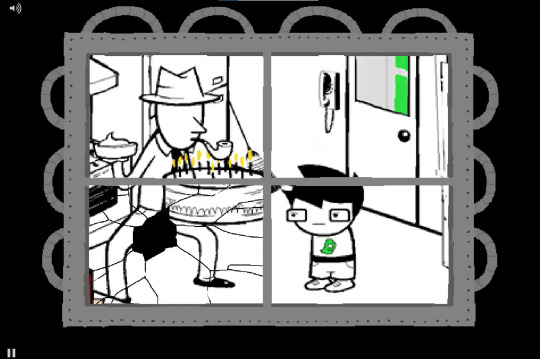
As a result of the extended panel-space established at the release of the red miles, we get to experience the majority of [S] Cascade’s action (and gorgeous artwork) on an enlarged canvas. Just as we go to the cinema to see movies on the “big screen,” Homestuck deploys its own big screen at the start of the flash. Then, all the growing and shrinking between segments contributes to the narrative flow of the flash. The “shrunk” portions leave room for the panel to blow up again once the next climax comes. I think the “wallpaper” effect employed mid-flash is especially effective, as it allows Hussie to continue utilizing the extended panel-space while keeping the frame small in advance of the Sn0wman’s death, at which point it expands again. It’s also important to note how Hussie manipulates our other preconceived expectations, aside from panel size, to enhance the animation’s drama. The website itself gets a special [S] Cascade color scheme and header. In the unfamiliar layout of this Cascade-ified website, readers prepare themselves for the best and the worst—then their expectations are thrown off balance again, for good measure, with the expansion of the panel and the big-screen execution of the flash. With all of this in mind, it’s easy to see how [S] Cascade generated such a massive response.
As you may be aware, as of January 2021 Adobe has discontinued its support for Flash Player, with all major web browsers following suit. This means it’s near impossible to run flash content on any normal computer, and it won’t be long before flash only exists in archival projects. Luckily, the new denizens of the Homestuck website have worked to keep all of the story intact despite the changing media landscape, with some interactive flash pages broken down into videos or screencaps and animations converted to embedded YouTube videos [3]. If you are interested in experiencing Homestuck’s flash content as originally released, a fantastic project called the Unofficial Homestuck Collection has worked to archive the entire comic in a custom browser which natively runs Flash (all you need is 4GB of space on your computer and some time for the assets to download). This archive has been invaluable for my art historical investigation into the comic [4].
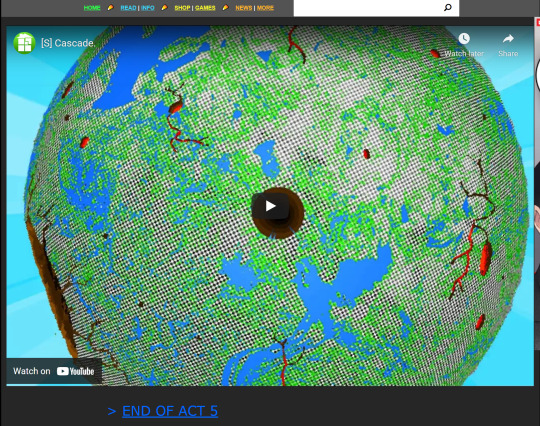
As it stands, though—unless forced by a concerned friend to download The Unofficial Homestuck Collection browser—new readers to Homestuck can’t experience the Flash games and animations in their original format. The same goes for folks rereading the comic. In the case of [S] Cascade, significant losses must be mourned. The effect set off by the red miles (the surprise and novelty of your “screen getting bigger”) is hampered by the embedded YouTube format. When you open the [S] Cascade page, now, it presents you with a mid-flash thumbnail, a YouTube play button, and YouTube framing elements such as a watermark and title (pictured above). You can’t avoid already seeing the extended panel-space of the flash page with this new format. Even though the panels within the embed begin in their “shrunk” state and grow to fill out the video frame, the expansion can never be a surprise to the same degree it was in the original Flash format. Flash animations were unornamented by watermarks, titles, and scrubber bars. They were so indistinguishable from regular static panels and gifs in terms of size, image quality, and framing that this gag (pictured below) actually worked. The indistinguishable quality of flash animations from regular gif panels created the necessary environment for [S] Cascade to surprise us by suddenly growing and filling the screen. That drama is inevitably lost in the flash’s new format.

On the other hand, the YouTube format presents some obvious benefits for readers. For one thing, you can now scrub back and forth in the animation, pause it, and even see its timestamps. This is beneficial to any reader who wants to revisit key moments and enormously helpful for someone like me analyzing the animation in detail. I would argue that the inability to pause the animation in its original format contributed to its monumental quality—readers couldn’t pause to breathe, and the comic took merciless control over the pacing—but of course the inability to pause something is also terribly inconvenient. Furthermore, the video format solves an issue that plagued Homestuck readers (including myself) throughout the comic’s lifetime: it’s inaccessibility on mobile devices. Adobe Flash famously failed to transition into the world of mobile touch-screens after Steve Jobs decided not to support it on the iPhone, writing a letter denouncing the software for its errors [5]. With Flash no longer functioning, the reformatted pages in Homestuck are all compatible with mobile devices, meaning readers can now enjoy the comic while lying sideways in bed like we always dreamed. Among other considerations, Adobe Flash was a complete pain to work with [6] for many large-scale projects, and its technical limitations cannot be ignored. On the whole, the death of Flash speaks to a greater evolution in our 21st century media sphere—the growing importance of mobile browsing, the shift from web-hosted games to apps and game launchers, and the increasing “convergence” of platforms into all-purpose devices. While much of Homestuck’s impact and charm resulted from its innovative use of Flash, like the example I’ve given in [S] Cascade, the unique bubble of history in which Flash existed should be fondly remembered and effectively preserved as we continue to navigate the comic’s legacy.
————————————————————————
Happy 4/13! If you liked this post, you can follow the blog on tumblr for updates or, if you don’t frequent tumblr, sign up for the mailing list to receive an email whenever I publish a new mini-essay!
————————————————————————
[1] I unfortunately can’t say I was around for the original [S] Cascade release (I started reading the comic about two years too late). However, even during the Gigapause, what I’ve called its “release mythos” was still widely retold. The events themselves are documented here: https://fanlore.org/wiki/Cascade_(Homestuck). Thank you to @imploder for having saved Vivi’s comic on tumblr!
[2] Hussie wrote about the making of [S] Cascade on his tumblr, now archived here: https://wheals.github.io/tumblr/tumblr.html#about-eoa5-part-1. This gives some insight into the massive undertaking. Previously, the longest animation in Homestuck was [S] Descend, an animation which Hussie calls “Cascade Lite” in his author commentary in Homestuck Book 3. [S] Descend was the first animation to significantly incorporate multiple plotlines moving along at once. Hussie describes this narrative style as an “action-collage” (also in the Book 3 commentary). [S] Descend was also (to my recollection) the first time Hussie significantly incorporated assets from contributing artists into an animation, which he explained was partially to keep the production moving faster. Ironically, during the production of [S] Cascade, organizing contributors turned out to be much more of a hassle—but ultimately Hussie deems the myriad of captivating art styles “a big plus” in his post.
[3] Although some are completely broken, now :(. RIP silly flute refrain.
[4] I seriously cannot overstate how grateful I am for this project.
[5] This article does a great job of explaining the history of Adobe Flash and its eventual demise.
[6] Hussie goes over some of the issues he had with the software in the post referenced at [2]
46 notes
·
View notes
Text
Press: Elizabeth Olsen’s 20/21 Vision
The Marvel star takes us inside her transformation to a new kind of hero

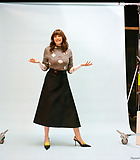


GALLERY LINKS
Studio Photoshoots > 2021 > Session 002
Magazine Scans > 2021 > Grazia
GRAZIA: Elizabeth Olsen is a trooper. We are in a field in Surrey on the outskirts of the Marvel studios; it’s a biting minus one and she is standing in a Chanel broderie anglaise sundress and increasingly soggy UGG boots. Her feline cheekbones face skywards, but Olsen is slowly sinking into the mud, trilling out high notes to keep herself warm (possibly distracted) and of course with spirits high. “It was the wind I think, that was worse than the sideways rain,” she jokes as we trundle back to the soundstage hangar that we are using as a studio. It’s the kind of moment that could go viral on Instagram, that is, if Olsen were on social media. Yet one of the biggest stars of our current cultural moment is completely offline – and that surprising fact might just be the least interesting thing about her. If anything, it is a sign of how Olsen has come into her own as a confident, decisive star with the power to create her own universe.
On the cusp of her 32nd birthday, Olsen is fastidious and professional, yes, but also bright, engaging, creative, and collaborative. Born and raised in the California sunshine, she is surprisingly at ease in the blustery conditions that deluge the English countryside in late January – or, it’s that she’s very good at acting. “It was one of the ugliest days of this winter – just hilarious – but I knew we wanted the shot,” the 31-year-old actress says.
Since October, Olsen’s been living in the leafy British countryside with her “man-guy-partner,” musician Robbie Arnett, just a short drive to the Surrey compound where Doctor Strange is being filmed. It’s a closed set, masked in secrecy as much as the socially distanced masked crew dotted all over the 200-acre studio. “It feels right being in a small city right now,” she says.
Indeed, Olsen is a modern-day Renaissance woman. Learned and dedicated to her craft, she studied at New York University’s Tisch School of the Arts, with a semester at the Moscow Art Theatre School studying Stanislavski. (Surely, no matter how much of a genius the Russian theatre master was, he never could have conceived of the Marvel universe.)
Approached with the concept of WandaVision, “I thought it was perfect for television, and a very original idea that made me excited,” Olsen says. Also, she was happy she would get to work with Bettany again: “He’s very precise, like me.”
In many ways, WandaVision is a love letter to the first American television heyday. Olsen, who stayed up late watching Nick at Nite reruns as a child, says it’s a bit of a homecoming in that way. “I was a very hammy, performative child,” she explains. “So, I do think I got to live out some sort of childhood dream doing the show.”
“The highlight was really getting to tell a story about these superhero individuals told in different decades of American sitcoms, trying to match the tone of those sitcoms in order to help orate the story,” she says. “But keep it playful and fun.” Little did she know just how much we’d need that.
Half-filmed pre-pandemic in Atlanta and half post-pandemic in LA – with a six-month hiatus in-between “until all the unions figured out to work safely” – WandaVision was released almost a year into the pandemic. In many ways, it is an artifact of its time: centered upon a yearning for the simplicity of earlier days, yet shot through with the creeping realization that such days may never return, and perhaps never existed to begin with.
Indeed, the weekly story of suburban superheroes Wanda and Vision has played out like a parable of our times: Wanda living in her chosen bubble, her trauma resonating in the world we find ourselves in today. Olsen appreciates a good metaphor, but feels people may be projecting a bit much. “I see Wanda as a victim of extreme trauma, who does not understand how to process it,” she explains. “She has been a human experiment.” (Not to belabor the point, but haven’t we all?)
Being summoned by Marvel is like being called to a parallel universe for an actor: thrilling, yes, but not without a tinge of terror and a dash of the unknown. Six years in, though, it’s become like family in some ways. As a member of two dynasties – Olsen and Marvel – family is key to Olsen. She checks in on her mom (who still lives in California) and, like many American daughters, is researching which vaccine mom should get.
The performative gene runs strong through her family, of course – and no, we don’t mean her sisters. Olsen’s mom was a ballerina. Still, when she first started auditioning, Olsen took special care to carve her own path – one far from Full House. “Nepotism is a thing and I’m very aware of it,” she says. “And of course, I’ve always wanted to do it alone.” She did just that, her acting credentials consistently rising as her sister’s cemented their fashion kudos. Olsen bears a noticeable resemblance to her fashion-designer older sisters and her sartorial DNA is similarly low-key. She loves The Row (of course) and NYC label Khaite’s denim and cashmere.
For Olsen, her day job is like playing dress-up. This time around, she walked away from WandaVision with the girdle worn underneath her 50s wedding dress, laughing, “I mean, to have a custom undergarment like that, I felt like it was necessary!” Her WandaVision co-star, Kathryn Hahn, also became her shopping cohort when filming.
“She’s dangerous!” Olsen says. “She has the most exquisite, minimal but expensive taste.” It was Hahn who led Olsen to the independent boutique where she found the belted Julia Jentzsch trench that she wore to our shoot.
At the rail of samples compiled by the stylist, Olsen gravitates towards a spacious linen boilersuit and longline cashmere cardigan. Has she always been a tomboy, I ask? “I think I felt uncomfortable being a child being told they were pretty,” she says of her early auditions at age 10, adding that her love of ballet and musical theater could leave her “feeling exposed” at a young age.
Speaking of over-exposure, Olsen is distinctly offline in a time when so many are defined by their social media presence. Among celebrities and regular digital citizens, the perfect balance of online and off is up for debate, but Olsen is clear: social media saturation is a choice for all of us, and everyone needs to draw their own boundaries.
“It has to be a personal decision, right?” she begins. “So, my opinion has nothing to do with what anyone else does or doesn’t do with it.” Her own journey began when she momentarily dabbled with Instagram (since deleted), while filming Ingrid Goes West, director Matt Spicer’s frightening and funny debut feature about a social stalker, co-starring Aubrey Plaza.
Up until that time, she says, “I had never touched it before. I thought, ‘This is an interesting social experiment for myself, to see if it is a good source to talk about charities or a good source to talk about small projects, or to share something goofier about myself.’ But I think at the end of the day, what I discovered was one, I’m really bad at creating a perceived identity!”
“I didn’t find it very organic to who I am as a person,” she continues. “I found some joy in putting up silly videos, but I think the main reason I stopped – not I think, I know the main reason why I stopped – was because of the organization in my brain.”
“Lots of horrible things happen all the time. Or, lots of great things happen all the time. Whether it’s something terrifying, like a natural disaster or a school shooting or a death, there are so many things that happen, and I love processing information. I love reading articles. I love listening to podcasts. I love communicating about things that are happening in the world to people around me. And what I don’t love is that my brain organization was saying, ‘Should I post about this?’ That seemed very unhealthy ….”
“And to then contribute to these platitudes that I don’t really love, you have to subscribe to two different ways of thinking,” she says. “So, I didn’t like that, and there was a lot of it that was just bothering me for my own sake of what value systems I have.”
That’s not to say that there’s any inherent value system – pro or con – in using Instagram. Olsen is clear that like any other method of expression, it’s up to the individual to use it as they see fit. “I do see a use of it and how you can use it well for work,” she says. “But I don’t think that I would like to use that tool to promote myself.”
She’s private for a millennial yes, but not prim. On the photoshoot, lockdown experiences were shared, and Olsen recounted her (hilarious) first at-home bikini wax: banishing her husband upstairs “for an extended chat with his therapist,” her trusted waxer on speed dial, and microwave set to ping! (Yes, Olsen is a trooper, as I mentioned.)
We catch up over Zoom a week later, her hair once again pulled up in a casual topknot, her cashmere turtleneck simmering in a dark claret, and her entire being suffused with covetable understatement. She chats buoyantly against an unexpected backdrop of pirate ship wallpaper in the playroom of a house she shares with Arnett, who proposed with an emerald and diamond ring in 2019.
“We first started to try to make it the gym, but it was so cramped,” she says of the jolly space. The home gym was instead awarded a larger room, where Olsen loves to maintain a varied fitness regime – running, yoga, dancing, more – though after all the intense Marvel filming, she jokes, “maybe it’s time to give up on my body?!” Being comic book fit does sound grueling or “time-consuming fun” as she anoints the “strenuous physical demands.”
Like most of us, she is longing for the spring, but she still takes a regular constitutional walk in a nearby Richmond park, whatever the weather. “The deer are incredible; every time I see them I feel alive,” she says. “We have been lucky to have nature around us in lockdown.” It’s a marked difference from her paparazzi-populated home in the Hills. “They know our walks, where we get coffee, work-out…,” she trails off.
Her haven in Los Angeles is her backyard, complete with a mid-century swimming pool and an edible garden. “It’s crazy the blackberries grow like weeds! I love watching a kid’s first reaction to an edible garden,” she gushes That has been the part of the pandemic travel restrictions she’s found hardest: missing her friend’s children growing up, and others who have been born this past year that she’s yet to meet. They will no doubt all be treated to her homemade blackberry sorbet on her return stateside.
Yet, her time on British soil will likely be prolonged, with a prospective indie commencing filming here when Doctor Strange wraps. Prompted for more detail, her firm charm kicks in. “I can’t jinx it!” she insists. Still, she will share that she’s heavily involved in the creative, and that funding smaller productions in the current climate has been a challenge.
Through it all, Olsen has remained determined and calm. “I feel patience is my superpower. But my weakness also,” she says. “I feel like it gets tested more than others who don’t have a lot of patience. If someone learns you’re easygoing or that you’re relaxed, sometimes it gets taken advantage of.” While she waits for the green light on that film, she is busy producing a new children’s cartoon with Arnett, “about loving and caring for our world,” and has also written a children’s book about to be published by Random House, all while the demands of Marvel life continue to surround her.
Indeed, Olsen is a superhero for the modern age: Multi-hyphenate, but fiercely devoted to the craft that she loves; instantly recognizable, yet thoughtfully protective of her private life; a woman with style, substance, success, and deep rewarding relationships with those around her; focused on a vision of a better world for us all.
Press: Elizabeth Olsen’s 20/21 Vision was originally published on Elizabeth Olsen Source • Your source for everything Elizabeth Olsen
#Elizabeth Olsen#WandaVision#Avengers#Scarlet Witch#Wanda Maximoff#Sorry For Your Loss#Avengers Infinity War#Avengers Age of Ultron#Captain America Civil War#Ingrid Goes West#Godzilla
24 notes
·
View notes
Text
The good, the bad and... SYAC: The Master Review 3
Not gonna lie, writing out this and the next part of my Master Review was more of a chore than the one before or even after (yes, certain later parts are almost wrapped up)
The reason is, that as of now the only thing I can really talk about is the quality of the average SYAC strip pre-Dobbear and quite frankly, most of them are just rather dull in one way or another.
See, here is the thing with Andrew Dobson in general: When you ignore his opinions outside of comics and assume that his works are not meant to be on a level equal to certain professional work, his stuff is rather harmless and to a certain extend enjoyable.
For example, I think Formera is in terms of pacing all over the place and Alex is “at best” on the same level as Garfield in terms of depth. Which would be okay if you look for something shallow to just distract yourself from boredom.

In fact, I find Formera, despite its flaws and blatant rip off of “wacky” anime aesthetics, rather admirable in a way.
But then you remember, that Dobson is a professionally trained comic artist and animator who aspired to be published at least in the same way as “Cleopatra in Space” or “Hilda”, while also throwing shade at many professionally released works and those behind it, as if to imply he is better than them.
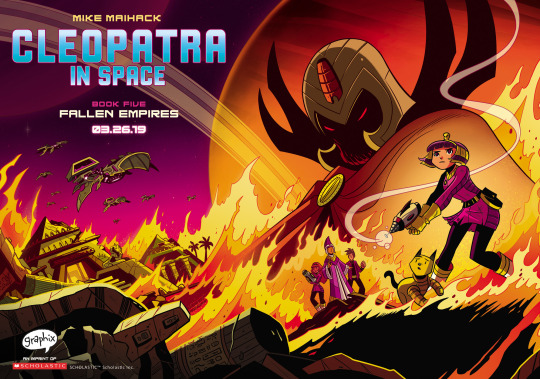



So with that in mind and his art at display, his work gets obviously judged on another level than certain other stuff online would likely be judged.
For example, as far as things go, this strip would be “passable” as a stupid joke that references Inspector Gadget, if just drawn by some hobby artist.
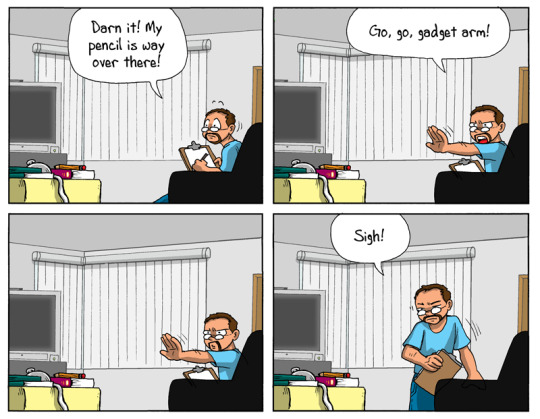
But as something from a “professional”? It’s rather underwhelming, even in something that is not meant to be the biggest selling point of him at the time it came out (serious sidenote: SYAC was essentially just a side project next to Alex ze Pirate and Dobson doing comics in collaboration with Brentalfloss. It was only after the collaboration ended and Dobson essentially put Formera and Alex into indefinite hiatus, that SYAC became his main comic)
It also doesn’t help (and sorry for repeating myself) that as far as his intentions go to make a comic about “silly problems” cartoonists face in creating their work, it still is filled with strips like these
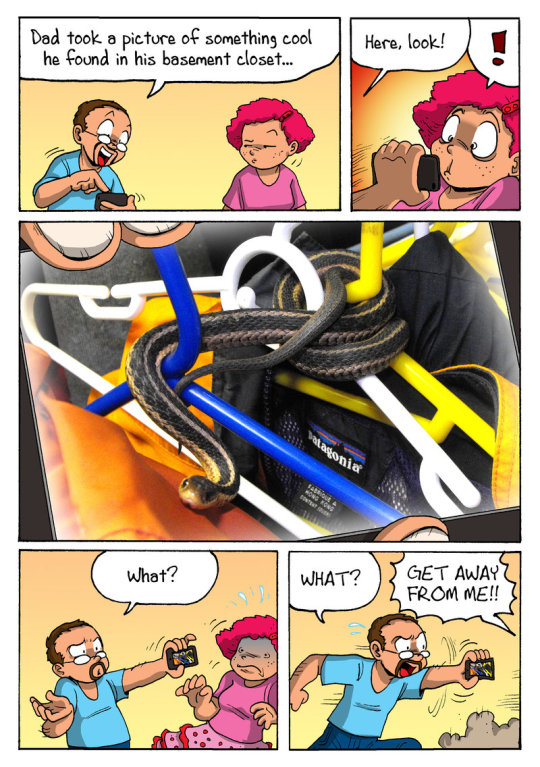



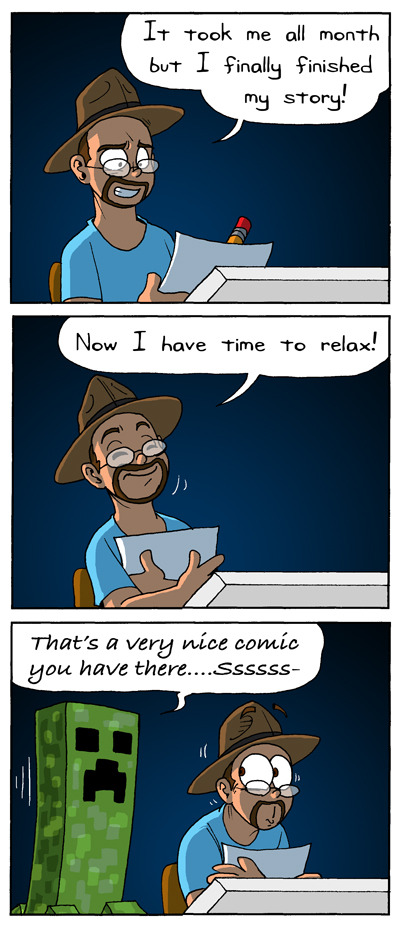
Like, what is the point of a comic showing you as a kid getting scared by the intro tune to the Ghostbusters theme on a shitty computer game? The only thing I can think of when it comes to the “magical changing tv” is that your lol face looks stupid and slightly punchable (like your cheeks are falling in) and what the joke about the Minecraft comic is supposed to be I have no freaking idea. I know that those green penises tend to explode, but what does that have to do with making a comic?
Now to be fair, there are some comics about the subject of creating comics…

And Dobson even has done some “tutorials” and q&a to teach people about his comic creating process.


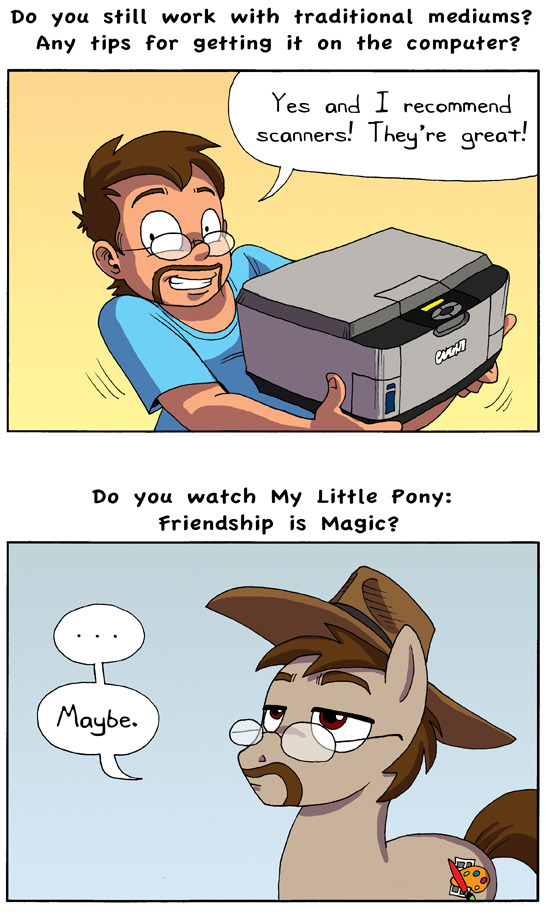
Tutorials whose advice I myself can not really judge, because frankly I am not an artist myself. I judge Dobson’s strips/comics primarily on execution of jokes, writing and intend. And frankly, as long as the final result looks good, I myself do not really care how it is achieved. The problem is, that the final results just tends to look kinda like this on average, so…

Yeah. And don’t get me even started on his “advice” to writing

As such, I would take ANY art advice by Dobson with a huge grain of salt
That said, I will give Dobson the following: This q&a strip here e.g. where he more or less talks about the nature of backgrounds in what seems to be a way more sincere tone than I see in his stuff on average?

I think it is kinda adorable and shows that he actually can draw more than just a self insert in front of a green void, if he just wants to.
Plus, I think there are actually some solid strips in SYAC. Not artistically, but I will admit that strips like this
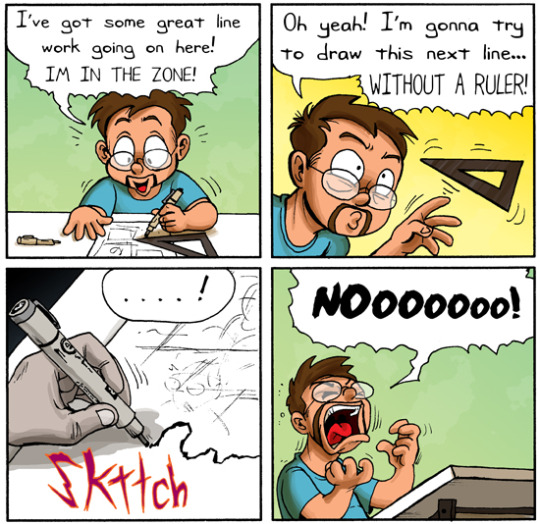
This…
And these…
182, 118 and 119, 120

And these...
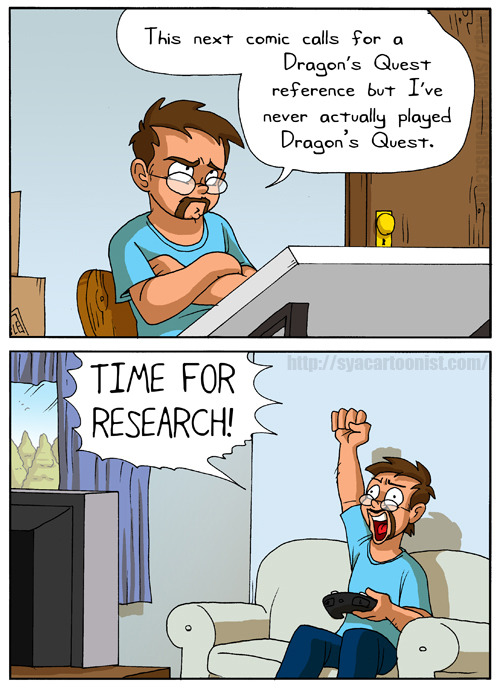
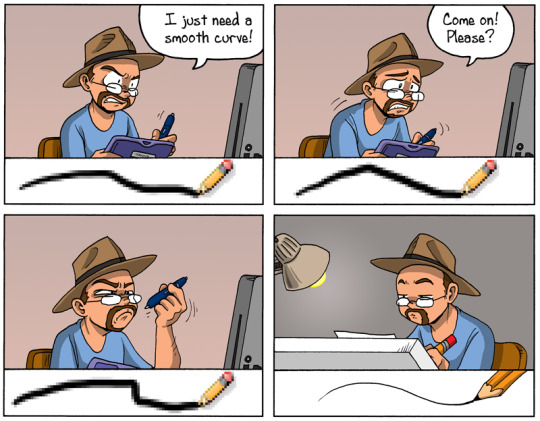
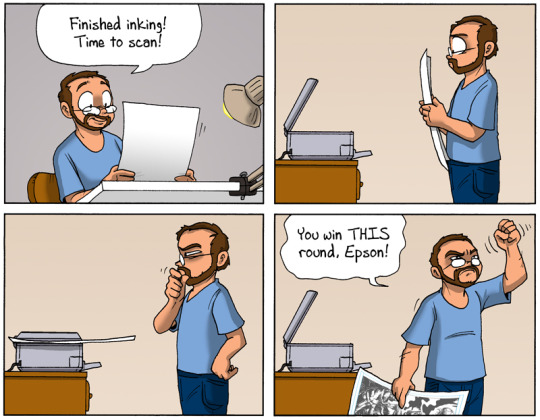
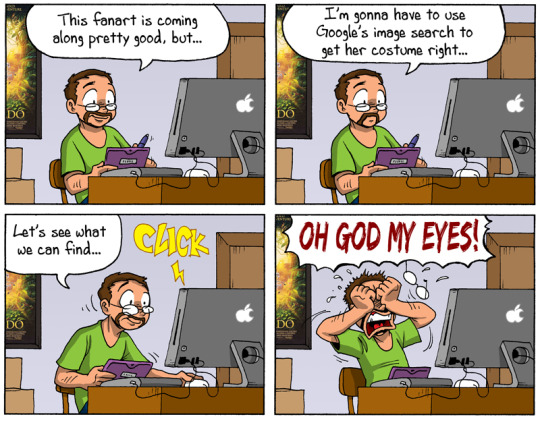
Are actually kinda fitting and situations I can imagine people to deal with when creating a comic. To me they are relatable, and the later got a chuckle out of me.
Even some strips of Dobson’s persona just at his booth or having his own “hilarious” moments in life are at least passable to some degree.
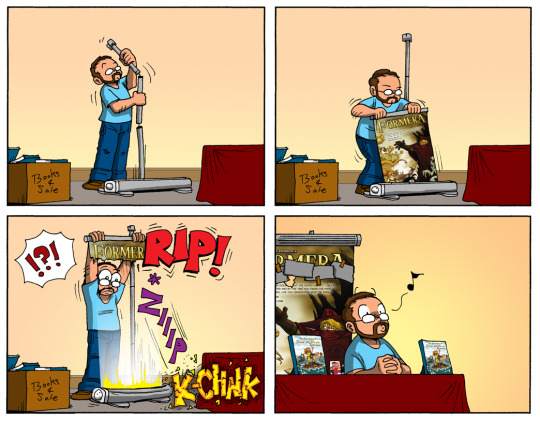


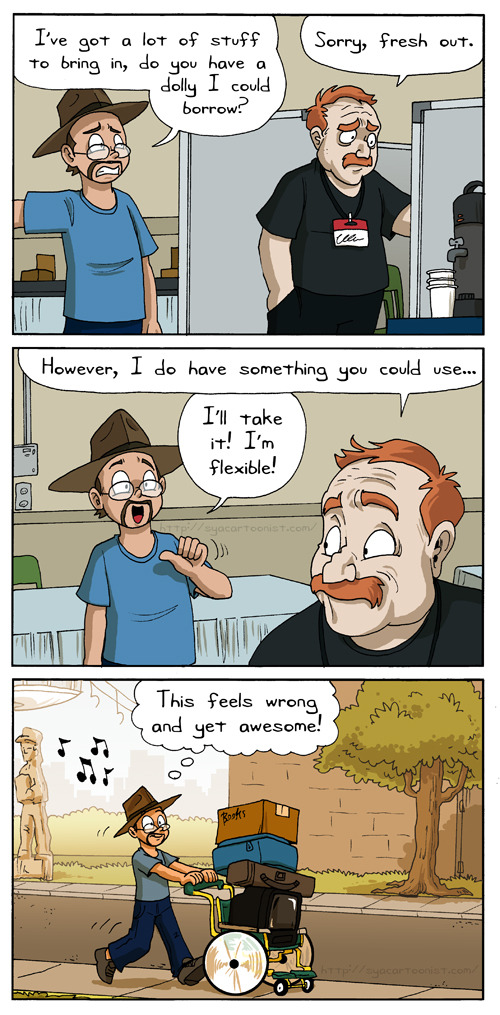
So shock of all shocks, not everything about SYAC, even at that time in Dobson’s life, was that bad. Like I give him credit, at least once upon a time he was able to make fun of himself…
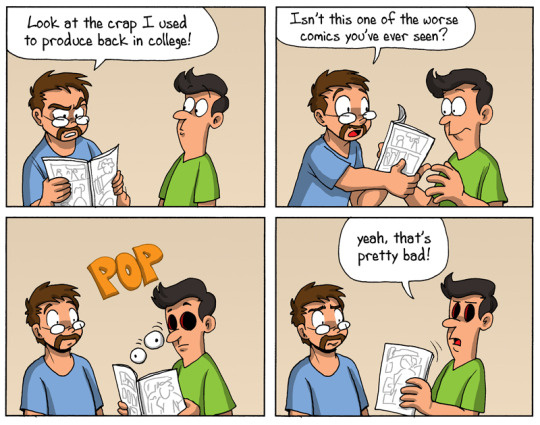

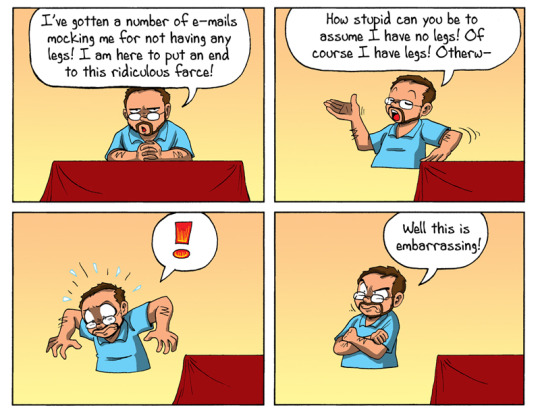

Heck, I give that copy pasta comic at least that as obvious as the joke is, it is a bit clever. Not the smartest joke, but it could be worse. At least here Dobson kinda admits he will do copy paste. Unlike when he whines about “sexist crap”

But then there are certain strips that at least are worth to raise an eyebrow. Like the anime related strips in the previous post or this bizarre confession in relation to one of his q&As.

Okay, I was thankfully saved from ever watching the atrocity known as Barney, so just let me check on google who the heck Baby Bop is to understand what… oh. And he drew artwork of Barney killing her. … that sounds kinda worrysome.
Then there is how Dobson e.g. decided to “address” his infamy regarding his opinion on Zelda-Ocarina of Time…
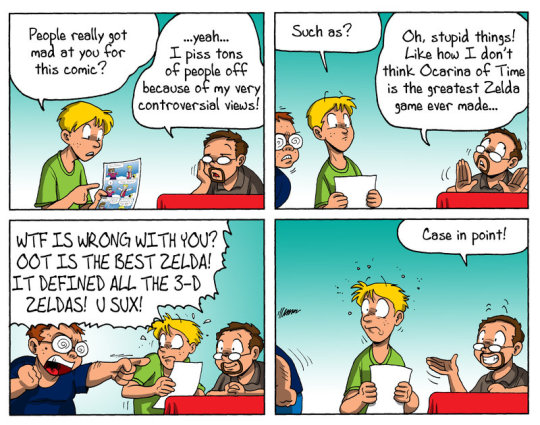
“hich involves a critic of his being portrayed as an ugly basement dweller. Or this comic, which got rather infamous once it got linked to Brianna Wu and Dobson would most likely want to forget nowadays, as it portrays him, the ally of the LGBT community as someone who actually is rather freaked out at men comfortable with a more feminine side/attire.

So now we have more or less covered some good and some bad ones. But what about the “ugly” ones? Yeah, that is going to be a quick skim through the archives with showing some strips that are going to stand out, because they give a first insight in how Dobson deals with criticism, perceives people (or rather stand ins for them) and their opinions, as well as how he tries and fails to catch up on certain trends.
#adobsonartworks#Andrew Dobson#syac#so you are a cartoonist#review#comic#webcomics#Tom Preston#adobsoncomic#adobsonartwork
22 notes
·
View notes
Text
GOOD NEWS
Hi, hello! I know I haven’t been making much content lately (The Greaser!AU has been holding my soul hostage ಥ_ಥ)
But Thanks to SOH I now have a pretty good handle on comic making (that and I just recently reawakened my love for gray scale ༼ つ ಥ_ಥ ༽つ)
I think I am actually going to be making and posting short and longish comics based on this BEAUTIFUL story that has captivated me body and soul. (oh boy another commitment lets see how far this one goes ಠ⌣ಠ)
Never in my wildest dreams did I expect this wonderful story to go as far as it has, there are SEASONS of beautiful story that has been created. I think it is high time that this beautiful story and the beautiful minds who helped create it get to see it come to life.
The comics themselves will focus on specific details that happen over the course of each season (In order of course since there is so much ground to cover) Of course as a creator I will only be doing the scenes that I have approval to do and make, this being a project being made by A L O T of beautiful souls. I do not wish to overstep my welcome as I have had my hand in many aspects of this story’s creation and I do not wish to destroy the vivid imagery that the other creators in this beautiful story had in mind.
There is SO MUCH content that has been made in LESS THAN A MONTH, there are a total of 8 SEASONS with 3 alternate timelines to boot! The wonderful and amazing people have dedicated so much time and energy to this story I want the world to experience and appreciate the wonder and beauty that this AMAZING collaboration has made.
So without further a do....keep your eyes open for work from the HIT television show “String Me Along” (DISCLAIMER: this is not an actual tv series, we just wrote the script as one but it can translate very well into comics, because that’s what I have access to ರ_ರ)
Now I would love to tag the wonderful people who brought this amazing story to life, because of their ideas and extraordinary minds we were able to create a wonderful story and they WILL be recognized for all the wonderful things they do! From art to writing each person is a STAR in their own unique way and I am so honored to be friends with each and every one of them!! They have become some of the closets people I have in my life and everything they do is SPECTACULAR in their own unique way! I want each and every person to be appreciated for what they do and to be seen. They deserve to be recognized for all the contribution they have put into this story!! SO....I want to extend personal thanks and THUNDEROUS APPLAUSE to: @puzzle-piece-angel, @vesuviansunshowers, @godofallthefuckingsrepents, @larknnightingale, @heartofnopal, @deathbyarcana, @caracalfeather @vesuviasfastestcourier @ryejett
Also suggestions from the audience on good tags to use for when this is released because help on that would be appreciated!!
#greaser!au#arcana#The Arcana AU#The Arcana Game#the arcana mc#arcana greaser!au#string me along serise#string me along announcements#string me along comic#comic serise#layne speaks#string me along season 1#lyra#kit#vy#quetz#axa#rose#maura#samaria#vis#orelia#vell#mavee#xander#ari
23 notes
·
View notes
Text
Rick and Morty: A Guide to Every Voice Actor
https://ift.tt/eA8V8J
The world of Rick and Morty has grown to absurd proportions. The show spans multiple planets, galaxies, timelines, and multiverses, meaning there’s always an opportunity to meet strange new people and creatures.
As such, Rick and Morty’s voice cast has grown along with the adventures of its titular pair. While co-creator Justin Roiland, Chris Parnell, Spencer Grammer, and Sarah Chalke have reliably voiced the central Smith-Sanchez family this entire time, the show also relies on a large crop of other voice actors. Some actors recur while others pop up only a time or two as very special guests. But all contribute to the rich aural tapestry of Adult Swim’s very ambitious animated series.
Gathered here is a list of (to the best of our knowledge) every voice actor who has popped up on Rick and Morty, who they played, and where you may have heard (or seen) them before.
Justin Roiland
Rick, Morty, Mr. Meseeks, Mr. Poopybutthole, Mr. Always Wants to Be Hunted
Justin Roiland is not just the co-creator of Rick and Morty but also the vocal engine for how much of the show sounds. Roiland portrays Rick, Morty, Mr. Meseeks, Mr. Poopybutthole, and countless other distinctively voiced characters in the show’s weird world. From the pilot on, Roiland’s tic-filled voice patterns have driven a lot of the humor behind the show.
Roiland has been an animator and a voice actor for quite a long time, getting involved with his eventual Rick and Morty co-creator Dan Harmon and his Channel 101 imprint back in 2004. There he made Internet-only cult animated series like House of Cosbys, and 2 Girls One Cup: the Show. His voice was previously well known as Earl of Lemongrab (“Unacceptable!!!”) in Adventure Time.
Chris Parnell
Jerry Smith
Former SNL cast member Chris Parnell has had a prolific career in comedy both as a live-action and voice actor. Parnell is best known for playing Garth Holliday in Anchorman: The Legend of Ron Burgundy, Dr. Leo Spaceman in 30 Rock, and many more roles in film and television. In the animation world he’s voiced characters on Archer, Robot Chicken, Gravity Falls, and beyond. His voice is often perfect for the “everyman” role and as such he has only been required to embody the sad form of Jerry Smith on Rick and Morty thus far.
Spencer Grammer
Summer Smith
The daughter of Kelsey Grammar, Spencer Grammar got her start as Casey Carywright on the ABC Family college dramedy Greek. Since then, she has done chiefly live-action work on shows such as CSI, Chicago PD, and Grey’s Anatomy.
Sarah Chalke
Beth Smith
Canadian actress Sarah Chalke brings two enormous roles from TV comedy’s past to her work on Rick and Morty. At first she was best known as the “second Becky” on ABC sitcom Roseanne. She would then go on to portray Dr. Elliot Reid for nine seasons of the classic Scrubs. Chalke is still chiefly a live-action comedic actress today but has done some more voice work in the past, including on Clone High and American Dad.
Kari Wahlgren
Jessica, Cynthia, Samantha, Mother Gaia
Kari Wahlgren works extensively as a voice actress for animated movies, TV shows, and video games. As evidenced by her character list above, she is often Rick and Morty’s go-to voice to portray one of Summer’s teenage peers.
Brandon Johnson
Mr. Goldenfold
Brandon Johnson is a familiar face and voice to Adult Swim audiences. He has previously popped up on NTSF:SD:SUV and American Dad. On Rick and Morty he voices Mr. Goldenfold, who is seemingly the only teacher at Morty and Summer’s school.
Phil Hendrie
Principal Gene Vagina
Philip Hendrie is best known for hosting The Phil Hendrie Show, a proto-Comedy Bang Bang-esque talk radio show in the 1990s where he portrayed both a fictionalized version of himself and many other wacky characters. He broke into animated voice acting in the late ‘90s, voicing dozens of characters on King of the Hill and popping up in Futurama as well. On Rick and Morty he plays the unfortunately named principal of Morty’s school.
Ryan Ridley
Frank Palicky, Lighthouse Keeper, Concerto
Ryan Ridley is a writer and producer on Rick and Morty, and like many of the show’s writers is sometimes called upon to lend his voice to a character or two. His best known creation is the Lighthouse Keeper on the Purge planet obsessed with his terrible screenplay. Ridley has also written for Ghosted, Blue Mountain State, and Community.
Rob Paulsen
Snuffles, Centaur
Rob Paulsen is a legendary voice actor best known for voicing two Ninja Turtles (Raphael and Donatello) and several Animaniacs characters. His filmography is truly impressive and includes the important role of Snuffles the Smith family dog on Rick and Morty.
Jess Harnell
Scary Terry, Ruben
Harnell is another Animaniacs veteran. After voicing Scary Terry and some additional voices in season 1, Harnell has yet to return to Rick and Morty.
Patricia Lentz
Joyce Smith
Patricia Lentz provides the voice of Jerry’s mom. She’s had a long, impressive career of live-action and voice acting with some highlights including Runaways, Sabrina the Teenage Witch, and Happy Days.
Dana Carvey
Leonard Smith
The voice of Jerry’s dad is provided by one of SNL’s better known alums in Dana Carvey. A master impressionist, Carvey was an important figure on SNL during the ‘80s and would go on to star in Wayne’s World, The Master of Disguise, and Trapped in Paradise. Shortly after his SNL career, he hosted The Dana Carvey Show, which did not last long but is notable in TV history for having an incredible cast of writers including Louis C.K. Charlie Kaufman, Jon Glaser, Robert Carlock, and frequent Dan Harmon collaborator Dino Stamatopoulos.
Echo Kellum
Jacob Philip, Brad, Triple Trunks
“I throw balls far. You want good words? Date a languager.” So sad that we had to leave Brad behind in C-137. Echo Kellum provides the voice of Brad and several other Rick and Morty characters.. Kellum is a UCB grad who has appeared in Key & Peele, Comedy Bang! Bang! and most notably Arrow as Mister Terrific.
John Oliver
Dr. Xenon Bloom
John Oliver now carries on the legacy of The Daily Show in his superb HBO news series Last Week Tonight. Prior to finding his perfect comedy news niche, Oliver had a lengthy comic acting career starting in his native England and extending into his new home in the U.S. Oliver previously played an important recurring role in Harmon’s Community and pops up just once on Rick and Morty.
David Cross
Prince Nebulon
David Cross is one of several sketch comedy legends who lent their voice to Rick and Morty as part of their lengthy careers. Cross created and starred in sketch series Mr. Show with Bob and David alongside co-creator Bob Odenkirk (how has he not popped up on Rick and Morty yet?). Since then he’s had a successful stand up career and been a part of some impressive TV ensembles such as Arrested Development.
Dan Harmon
Birdperson, Kevin, Mr. Marklovitz, Davin, Ice-T, Dr. Glip-Glop, Nimbus
Dan Harmon is the co-creator of Rick and Morty alongside Roiland. The two share a long history going back to the Channel 101 days. While both Roiland and Harmon are skilled storytellers, Harmon has truly delved into the science of story throughout his career. Harmon is best known for creating and showrunning Community, which became an onscreen sensation for fans and an offscreen nuisance for NBC due to Harmon’s at times difficult behavior. On Rick and Morty, Roiland and Harmon deploy Harmon’s deadpan delivery to good use, with him often playing monotone characters like the beloved Birdperson.
Tom Kenny
King Jellybean, Squanchy, Conroy, Million Ants, Etc.
Tom Kenny is an incredibly successful voice artist who you likely best know as none other than SpongeBob SquarePants. On Rick and Morty, Kenny’s roles are decidedly less wholesome than the sponge who lives in a pineapple under the sea. Kenny was a big factor in season 1 playing King Jellybean and Sqaunchy. He’s popped up sparingly in seasons 2, 3, and 4 as well, most notably as Million Ants of the Vindicators.
Cassie Steele
Tammy Gueterman, Tricia Lange
Somebody’s gotta play Tammy Gueterman, that traitorous monster. And that “honor” goes to Cassie Steele. Steele’s name is recognizable to Canadian (and some American) audiences due to her role as Manny Santos on Degrassi: The Next Generation. Rick and Morty was her first voice acting role. She will continue her voice acting career as the lead in Disney’s upcoming Raya and the Last Dragon.
Claudia Black
Mar-Sha/Ventriloquiver
Claudia Black has turned up on Rick and Morty twice, once in season 1 and once in season 4. It’s a surprise she hasn’t done so more often as she’s built up quite the voice acting career. After becoming well known in sci-fi series like Farscape and Stargate SG-1, Black continued on into a successful gaming career, providing her voice to Uncharted, Gears of War, and Dragon Age.
Maurice LaMarche
Morty Jr. Brad Anderson, Abradolf Lincler, Crocubot
Maurice LaMarche’s smooth baritone is quite familiar to many animation fans. LaMarche has voice acted in everything from Animaniacs to Futurama. He’s got a killer Orson Welles impression and that seems to be the starting point for many of his Rick and Morty characters.
Alfred Molina
Mr. Needful
Many of us know Alfred Molina from his incredibly successful film career in projects like Boogie Nights, Spider-Man 2, and The Da Vinci Code. But Molina has also had quite the career as a voice actor as well. In the past couple decades, Molina has lent his sturdy voice to Rango, Monsters University, Ralph Breaks the Internet, Frozen II, and more. He was clearly a shrewd choice for the Lucifer-like Mr. Needful. It’s a wonder why he hasn’t turned up on Rick and Morty more.
Richard Fulcher
King Flippy Nips
Richard Fulcher is best known as the unofficial third member of British comedy troupe The Mighty Boosh, though he himself is American. Fulcher wrote and acted in every incarnation of The Mighty Boosh. He has also had a prolific career in comedy acting outside the troupe. As of late, Fulcher has leaned into his voice acting abilities including this sadly one-off role on Rick and Morty as King Flippy Nips, ruler of Pluto.
Nolan North
Scroopy Noopers, Multiple Others
Nolan North has done extensive videogame work in franchises such as Uncharted, Assassin’s Creed, and the Arkham series. That’s right: the voice of shrimpy Plutonian Scroopy Noopers on Rick and Morty is both Nathan Drake and Desmond Miles. North also voices many other characters in positions of authority for the show.
Aislinn Paul
Nancy
Aislinn Paul is another Degrassi: The Next Generation alum who has broken into the voice acting world. On Rick and Morty, Paul plays only Nancy, Summer’s nerdy classmate who everyone is always mean to. Hopefully one day there will be justice for Nancy.
Alejandra Gollas
Lucy
Alejandra Gollas is a bilingual Mexican actress who has acted in films, TV shows, and stage productions for decades. Her only Rick and Morty role was that of creepy Titanic enthusiast Lucy.
Scott Chernoff
Revolio Clockberg Jr.
Originally referred to as “Gearhead,” Revolio Clockberg Jr. is one of Rick and Morty’s most recognizable recurring characters. Embodying this important role is veteran voice actor and TV writer Scott Chernoff. Chernoff has lent his voice to dozens of animated properties and has even written for many successful comedies including BoJack Horseman, The Tonight Show with Conan O’Brien, and School of Rock. He is one of many Channel 101 veterans involved in Rick and Morty and pitches in with some other background voices on the show here and there.
Keegan-Michael Key
Schleemypants
Keegan-Michael Key is likely best known as half of the ultra successful sketch comedy duo Key & Peele. (Wonder whatever happened to the other guy!) Key has had an enormously successful career as a comedic actor on television. On Rick and Morty he plays testicle-looking time cop Schleemypants.
Jordan Peele
Second Fourth-Dimensional Being
Oh, here’s Peele! Schleemypants’ unnamed partner is the only character Peele has played on Rick and Morty.
Jemaine Clement
Fart
New Zealand comedic actor Jemaine Clement is best known for being half of the Grammy award-winning comedic musical act Flight of the Conchords alongside Bret McKenzie. Clement has also worked extensively with fellow Kiwi Taika Waititi to produce recent classics like What We Do in the Shadows. His deadpan delivery was a perfect choice monotone gaseous being “Fart.”
Andy Daly
Krombopulos Michael
Krombopulos Michael is Rick and Morty’s Boba Fett: he looks cool but ultimately does nothing. Playing K.M. was one of the most sought-of “character voice actors” in the industry. Daly’s cheerful everyman delivery has proven useful on dozens of comedy shows across the entertainment landscape. Perhaps best known for his starring vehicle Review with Forest MacNeil, Daly has also lent his voice to series such as Harley Quinn, Bob’s Burgers, and Big Mouth. He can also be heard as a crucial role on Roiland’s Solar Opposites.
Christina Hendricks
Unity
Christina Hendricks is best known for her role as Joan Holloway on Mad Men. In addition to that, however, she’s appeared in quite a few genre films and shows like Firefly, Life, and The Neon Demon. Hendricks has done some voice work here and there and her only role on Rick and Morty to date is assimilation expert and one-time Rick Sanchez paramour Unity.
Patton Oswalt
Beta-Seven
Patton Oswalt is basically the dark matter of the comedy universe. He and his voice turn up just about everywhere. Perhaps his best known voice acting role is that of lead character Remy in Ratatouille. On Rick and Morty he has played only Beta-Seven thus far and is surely due for some more appearances.
Keith David
The President
Even if you’ve never heard of Keith David, you have surely heard his voice. An unmistakable baritone with gravitas, David has leant that voice to projects such as Gargoyles, Halo, and Spawn. David has worked with Harmon before on the final season of Community. Surely, there is no better voice for Rick and Morty’s unnamed President…or its Reverse Giraffe.
Kurtwood Smith
General Nathan
Not sure if you recognize Kurtwood Smith’s voice? You would if he called you a dumbass. Yes, Smith is best known to TV audiences as Eric Forman’s ornery dad Red on That ‘70s Show. He provides that same ornery spirit to the role of General Nathan on Rick and Morty in “Get Schwifty.”
Stephen Colbert
Zeep Xanflorp
Stephen Colbert is of course a longtime comedic actor, host of The Colbert Report, and now host of The Late Show on CBS. The Late Show understandably takes up most of his time nowadays but he was nice enough to portray the intelligent alien living inside Rick’s flying saucer’s Miniverse battery.
Nathan Fielder
Kyle
“The Ricks Must Be Crazy” has quite the star power among its voice cast. In addition to Colbert’s Zeep, the episode also introduces another Microverse populated by Kyle. Kyle is played by Nathan For You’s cringe comedy maestro Nathan Fielder.
Jim Rash
Glaxo Slimslom
Jim Rash is another frequent Dan Harmon collaborator, best known for his role as Dean Pelton on Community. Rash is an accomplished comedic actor and an Oscar award-winning screenwriter. He’s the perfect choice to play alien couples counselor Glaxo.
Matt Besser
Fungo
Matt Besser is an improv comedy specialist who is a founding member of the Upright Citizens Brigade comedy troupe. Over his long career, he’s appeared in just about everything. On Rick and Morty he portrays alien diplomat Fungo, who tries to convince Jerry to donate his penis to Shrimply Pibbles.
Werner Herzog
Shrimply Pibbles
Werner Herzog might be the strangest inclusion in the Rick and Morty voice canon. Herzog is a towering figure in the cinema world as a director, screenwriter, documentarian, and occasional actor. His German accent and generally serious and pessimistic disposition has made him a natural target for comedies looking to inject a bit of weird humor into the proceedings.
Chelsea Kane
Arthricia
Chelsea Kane has appeared in several TV series targeted to tween audiences like Disney Channel’s Jonas and Freeform’s Baby Daddy. Her brief role as the Purge planet’s Arthricia was a jumping off point to try more voice actor roles on shows like Hot Streets, Regular Show, and DC Super Hero Girls.
James Callis and Tricia Helfer
Pat and Donna Gueterman
James Callis and Tricia Helfer portray the parents of double-agent Tammy Gueterman for a very specific reason. Callis and Helfer are best known for their roles on Syfy’s classic series Battlestar Galactica, with Callis playing brilliant scientist (and traitor to humanity) Gaius Baltar and Helfer playing Cylon model Number 6. Pat and Donna Gueterman on Rick and Morty look just like the actors playing them, which should have been our first clue that something is amiss.
Nathan Fillion
Cornvelious Daniel
Who is Nathan Fillion if not nerd culture’s best friend? Fillion came into prominence by playing Captain Mal Reynolds on Joss Whedon’s beloved Firefly. Since then Fillion has had a solid career on shows like Castle and The Rookie. In his spare time, however, he provides his voice to animated series like Rick and Morty and Big Mouth, often playing a thinly-veiled version of himself. Cornvelious Daniel is notable for being the first character onscreen in Rick and Morty to enjoy that sweet, sweet McDonald’s Szechuan sauce.
Tony Hale
Eli
Tony Hale won two Emmys for playing the Vice President’s bagman Gary Walsh on Veep. Before that he was the youngest Bluth child, Buster, on Arrested Development. As of late, however, he’s getting more into the voice acting scene. You (or your kids) may best know him as the beloved Forky in Toy Story 4. But prior to that, he popped up as a cheery Mad Max-style biker named Eli on Rick and Morty.
Joel McHale
Hemorrhage
Joel McHale is, of course, another Community alum. He played lead character Jeff Winger on Harmon’s old NBC series. In addition to that, McHale has had a lengthy career in comedy, having hosted The Soup and Netflix’s recent Tiger King special. He was also a tight end of the University of Washington football team but that’s neither here nor there. He voices bucket-wearing post-apocalyptic warlord Hemorrhage on Rick and Morty.
Susan Sarandon
Dr. Wong
Perhaps no character on Rick and Morty has delved deeper into Rick’s psyche than Smith-family psychologist Dr. Wong. Lending her voice to Dr. Wong in the infamous “Pickle Rick” episode is legendary actress Susan Sarandon a.k.a the Louise in Thelma and Louise.
Peter Serafinowicz
Agency Director
Peter Serafinowicz is a British comedian and actor who used his role voicing Darth Maul in The Phantom Menace as a launching pad to befriend some truly talented creators and get some truly fascinating roles. Serafinowicz has popped up in Shaun of the Dead, Guardians of the Galaxy, Parks and Recreation, and more. He also portrayed the titular Tick in Amazon’s The Tick. His role in Rick and Morty is briefly that of a Russian villain agency director who tries to take down the ever-elusive Pickle Rick.
Danny Trejo
Jaguar
“Pickle Rick” really has quite the impressive guest voice cast. Danny Trejo joins Peter Serafinowicz and Susan Sarandon in lending his voice to this episode. Trejo plays Rick’s loose canon action hero ally, Jaguar. Outside of Rick and Morty, Danny Trejo may be one of the most recognizable faces in entertainment. A frequent collaborator of Robert Rodriguez, Trejo has leveraged his fascinating upbringing and tough guy appearance into countless roles.
Gillian Jacobs
Supernova
Another Community alum! Superhero team The Vindicators requires a lot of guest voice talent and clearly Dan Harmon knew one place to turn. Jacobs played Britta on Community (she’s the worst). The Pittsburgh-born actress has also appeared in Girls, Don’t Think Twice, and Ibiza.
Christian Slater
Vance Maximus
Christian Slater is a big get for Vindicators leader Vance Maximus. While he’s best known to modern audiences as the titular Mr. Robot in Mr. Robot, Slater got his start as an actor with popular roles in movies like Heathers, Interview with the Vampire, and Broken Arrow. Slater has had a fruitful voice acting career as well, having previously played “Slater” in Archer.
Lance Reddick
Alan Rails
Alan Rails is another one of the hallowed Vindicators crime-fighting team. Playing the ghost train-summoner is Lance Reddick. Reddick has been a mainstay on television for decades, turning up in Oz, Fringe, Lost, and more. Most notably he played Cedric Daniels for the entirety of The Wire’s run.
Logic
Logic
Logic is one of the few Rick and Morty guest stars who gets to be an animated version of himself. This Maryland-based rapper has released five successful albums and enlisted Rick and Morty to help promote his sixth mixtape Bobby Tarantino II.
Clancy Brown
Risotto Groupon, Story Train passenger
Talk about a guy with a commanding voice. Clancy Brown has been a successful actor for a long time, going back to his roles in Highlander, The Shawshank Redemption, and Lost. He’s undoubtedly best known to animation fans, however, as the voice of stingy Krusty Krab owner Mr. Krabs in SpongeBob SquarePants. On Rick and Morty, he’s played alien restaurant manager Risotto Groupon and a Story Train passenger in season 4’s “Never Ricking Morty.”
Thomas Middleditch
Tommy Lipnip
Thomas Middleditch is likely best known to television audiences as overmatched tech tycoon Richard Hendrix on HBO’s Silicon Valley. That’s just the tip of the iceberg for Middleditch’s comedy career. The prolific improviser played Tommy Lipnip in Rick and Morty and must have impressed Justin Roiland enough to give him a lead role on his Hulu comedy Solar Opposites.
John DiMaggio
Multiple Minor Roles (Death Stalker, Leader, Knight, etc.)
John DiMaggio is an incredibly busy voice actor. If you’ve ever enjoyed an animated comedy, there’s a good chance DiMaggio contributed his voice to it. His best known roles include Bender on Futurama, Jake the Dog on Adventure Time, and Scotsman on Samurai Jack.
Sherri Shepherd
Judge
Sherri Shepherd is an actress, comedian, and TV personality best known for being a co-host on The View for seven years. Since then she’s turned up as an actress or talking head on many shows and lent her voice to portray a judge that deals with Morty in the season 4 premiere.
Sam Neill
Monogatron Leader
In addition to having one of the best Twitter accounts in the world, Sam Neill is also an actor best known for playing Dr. Alan Grant in Jurassic Park and Jurassic Park III. The New Zealander has continued to work quite a bit in recent years, turning up in Thor: Ragnarok and Peaky Blinders. On Rick and Morty he plays the leader of the Monogatron alien race in “The Old Man and the Seat.”
Taika Waititi
Glootie
Playing another Monogatron, this one named Glootie, is New Zealand actor/director Taika Waititi. Waititi got his start in the New Zealand comedy scene alongside other Rick and Morty guest star Jermaine Clement. Since then he has only gone on to become one of the most in-demand filmmakers on the planet. Waititi is behind Thor: Ragnarok, JoJo Rabbit, and an upcoming Star Wars film.
Kathleen Turner
Monogatron Queen
Kathleen Turner is what you would call a “get” for Rick and Morty. Turner has won two Golden Globe awards and been nominated for an Oscar and several Tony awards. She is best known for her roles in ‘80s movies Romancing the Stone, Prizzi’s Honor, and The War of the Roses. Turner has also been working as a voice actress since the ‘80s, voicing Jessica Rabbit in Who Framed Roger Rabbit and going on to act in The Simpsons and King of the Hill as well.
Jeffrey Wright
Tony
Jeffrey Wright is no stranger to sci-fi, having toiled away as sad robot Bernard on Westworld for three seasons. Wright got three-quarters of a way to an EGOT in one role by playing Belize in Angels in America. Since then he’s acted in several Daniel Craig Bond films, Boardwalk Empire, and The Hunger Games. On Rick and Morty he plays the role of an alien who vexes Rick into an existential crisis by continuing to use his private toilet.
Elon Musk
Elon Tusk
Elon Musk is a South African/Canadian/American engineer and industrialist who serves as the founder and CEO of SpaceX and CEO of Tesla, along with numerous other ventures. Presumably he did not call anyone behind the scenes of Rick and Morty a pedophile but you never know.
Justin Theroux
Miles Knightley
Justin Theroux has had quite the career in Hollywood. He first came to prominence acting in the David Lynch films Mulholland Drive and Inland Empire. He then continued to appear in major films while also writing some for good measure like Tropic Thunder, Iron Man 2, and Rock of Ages. On television he played Kevin Garvey in HBO’s The Leftovers. For Rick and Morty, he played the role of “heist artist” Miles Knightly in “One Crew Over the Crewcoo’s Morty.” You son of a bitch, I’m in.
Pamela Adlon
Angie Flint
Pamela Adlon is the rare case of an actor who was first best-known for voice work breaking into the live-action arena in a big way. Adlon is best known for giving voice to Bobby Hill on King of the Hill, while also voice acting in other animated projects like Recess, and 101 Dalmatians: The Series. A longtime collaborator of Louis C.K. (though not so much anymore), Adlon appeared on FX’s Louie and got a well-received FX show of her own, Better Things. On Rick and Morty, Adlon portrays Angie Flint – a lock-picker who Rick recruits to his heist team.
Matthew Broderick
Talking Cat
Matthew Broderick is a longtime stage, film, and television actor best known for his roles on Ferris Bueller’s Day Off, WarGames, The Producers, and much more. Most recently he turned up on Netflix’s sadly-departed post-apocalyptic comedy Daybreak. On Rick and Morty, Broderick plays a Talking Cat with a secret so heinous it will drive anyone to near insanity.
Liam Cunningham
Balthromaw
To portray the voice of a wizened dragon, Rick and Morty turned to an actor best known for a series filled with them. The Irish actor Liam Cunningham is known to most people as Ser Davos Seaworth from Game of Thrones. Though not usually a voice actor he must have enjoyed his role on Rick and Morty as he turns up again briefly in Roiland’s Solar Opposites.
Phil LaMarr
Multiple Minor Roles
The first two things most people (and by most people I mean me) think of when they think of Phil Lamarr are his time on Mad TV and the moment his head explodes on Pulp Fiction. But aside from sketch comedy and head explosions, LaMarr has had a remarkable voice acting career. He portrayed the title character in Samurai Jack while also providing his voice to Justice League, Static Shock, and countless video games. It’s surprisingly hard to figure out what voices Phil LaMarr plays on Rick and Morty but given his talents it’s certain to be quite a few.
Christopher Meloni
Jesus
When Rick and Morty briefly presented the savior of mankind in season 4’s sixth episode, surely there was only one choice to play him. Christopher Meloni has had one of the more fascinating careers in entertainment. After playing the deadly serious role of Elliot Stabler on Law and Order: SVU for years, Meloni has re-embraced his comedic side in projects like Happy!, Harley Quinn, while reprising his role in the Wet Hot American Summer franchise.
Paul Giamatti
Story Lord
Paul Giamatti once joked in a late night talk show interview that his role in any given heist or action movie would be the guy wearing a headset in a van, typing on a computer, and telling the hero to “get out of there, man!” He has since parlayed that character actor sensibility into a remarkable, multi-award-winning career. Giamatti is best known recently for portraying Chuck Rhoades on Billions and producing AMC’s Lodge 49. Prior to that he played lead roles in American Splendor, HBO’s John Adams, and much more. The guy has a good handle on stories and therefore makes perfect sense as Rick and Morty’s Story Lord.
Alan Tudyk
Chris, Observant Glorzo, Multiple Minor Roles
Alan Tudyk is a nerd culture mainstay. Very few comic-cons come and go without Tudyk involved in at least one project presenting within them. Tudyk has played Hoban “Wash” Washburne on Firefly and its spinoff movie Serenity, Mr. Nobody on Doom Patrol, and many more beloved characters. His live-action appearances are just the tip of the nerd iceberg, however, with Tudyk providing his voice to everything from Solo: A Star Wars Story (K-2SO) to Harley Quinn (Clayface/The Joker). On Rick and Morty, Tudyk plays several unnamed characters.
cnx.cmd.push(function() { cnx({ playerId: "106e33c0-3911-473c-b599-b1426db57530", }).render("0270c398a82f44f49c23c16122516796"); });
Rob Schrab
God
Rob Schrab is a Channel 101 veteran and longtime Harmon collaborator. Schrab is best known for his work as a director of projects like Monster House, Community, Parks and Recreation, and more. On Rick and Morty he plays none other than God…or at least the Zeus-like god of a remote planet.
Jim Gaffigan
Hoovy
Jim Gaffigan is a wildly successful standup comedian who co-created and starred in a TV show about his life for TV Land called The Jim Gaffigan Show. While he’s appeared sparingly in films, of late he’s dabbled in voice acting, lending his voice to Hotel Transylvania 3, Playmobil: The Movie, and Luca. His kindly Midwestern accent lends itself nicely to the helpful but doomed Hoovy on Rick and Morty.
Planetina
Alison Brie
Five seasons in and Rick and Morty is still finding old friends from Community to make their debut. Alison Brie played Annie Edison on Dan Harmon’s classic series. Since then she’s become quite the star, serving as a lead on GLOW and voice acting in BoJack Horseman and The Lego Movie 2. She even provided the voice of Natasha Romanoff a.k.a. Black Widow in the video game Marvel Avengers Academy.
Steve Buscemi
Eddie
Steve Buscemi is a prolific and talented character actor known for his classic roles in Fargo, Reservoir Dogs, The Sopranos, and more. That he plays such a relatively minor role on Rick and Morty suggests that he might be a fan of the show and just wanted to stop by and say hey. Buscemi is also notable for being a New York firefighter prior to his acting life.
Christina Ricci
Princess Ponietta
Once known as a talented child actor, Christina Ricci has continued her creative work into adulthood. The actress has starred in films like Speed Racer, Black Snake Moan, and the upcoming fourth Matrix movie. Bless her for dropping by Rick and Morty only to play an CHUD horse-person princess pregnant with Rick’s heir.
Kyle Mooney
Blazen
Kyle Mooney is an SNL cast member and writer who specializes in offbeat characters and sketches. He also wrote and starred in 2017’s Brigsby Bear. His role hasn’t been officially confirmed on Rick and Morty yet but it seems as though he voices the Mortal Kombat-esque faux badass Blazen.
The post Rick and Morty: A Guide to Every Voice Actor appeared first on Den of Geek.
from Den of Geek https://ift.tt/2TZnSGJ
3 notes
·
View notes
Text
Lynn Gunn’s Honest Portrayal of PVRIS’ Past, Present and Future Plus Details on New LP ‘Use Me’ [Q&A]
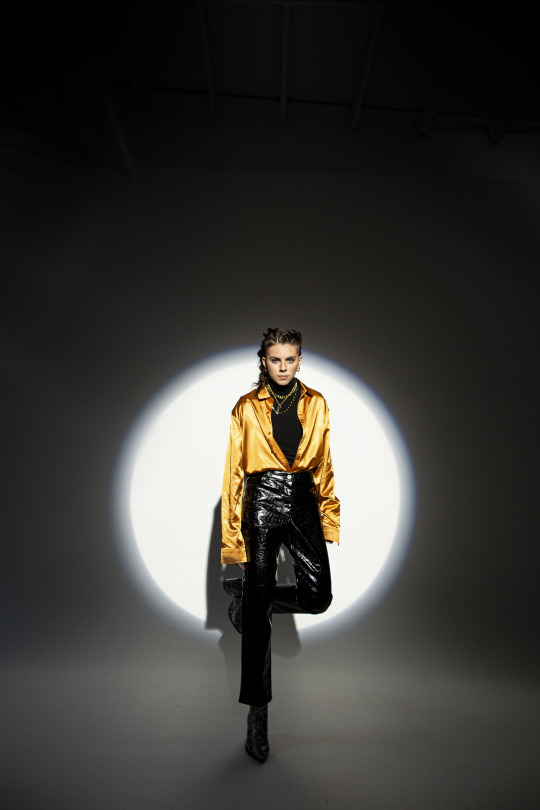
Did you know that quicksand cannot really sink your entire body? Hollywood renditions of this frightening occurrence showcase “Indiana Jones” type heroes desperately reaching for a branch or a vine to evade being swallowed whole by the muddy foe. In real life, however, quicksand is much denser than the human body–namely your torso and lungs. So, although you may sink to some degree, you’ll only be engulfed to about your torso region. That being said, to escape the hold of this mucky captor, you’re called to utilize, not a vine or a stick, but a natural aspect of yourself–in this case, the buoyancy of your torso and lungs. Doing so allows you to adjust your positioning so that you are on your back and are therefore more easily able to free your legs and eventually, yourself.
During moments of crisis such as this, it is not often that we think to use what comes most natural to us in order to overcome difficulties. However, as PVRIS frontwomxn Lynn Gunn discovered, tuning into your natural inclinations can be exactly what sets you free.
After battling debilitating health issues, anxieties, and multiple album delays, the refreshingly new album Use Me is here, and it has the empowered LGBTQIA+ artist plastered all over it. From the distinctively raw lyrics, impassioned vocals, dexterous commixture of that classic PVRIS Alternative Rock and new-aged Glitch-pop, and even a 070 Shake feature, this new album is taking everything we thought we knew about PVRIS to much higher heights. Use Me serves as the first release since Gunn followed her heart and came forward as the sole architect behind PVRIS back in March. After listening to all 40 emotion-inducing minutes of this cinematic project, it becomes clear that Use Me is so much more than an album, it is an unapologetic reclamation of power.
We were able to speak with Lynn Gunn before the release of the album and gather her perspective on this new era of creativity, utilizing her natural abilities for this new project, and even on supporting social justice causes.
All quicksand jokes aside, sink into this interview with Lynn Gunn below:
Ones to Watch: Although you’ve been making music for quite some time, this new era seems to be of a new bloom, not only for PVRIS, but for you. As you have stated, PVRIS is still very much a collective, but you have decided to shed the skin of “band culture” and from it emerge as the sole vocalist, lyricists, and creative director of PVRIS. How has that transition been on you all? Are people taking to it the way that you imagined?
Lynn Gunn: I didn’t really imagine anyone taking it any way, to be honest, it’s happening regardless of what others want to say or feel about it. It’s felt great personally and as a unit. I’ve seen mostly support but obviously, with anything, there’s always going to be people with the opposite. At the end of the day, this is what this is moving forward and works best for us, I know my truth and what this journey has been and looked like so far. I’ve seen so many insane and comical theories and conspiracies about the transition/negative comments… but ultimately I think anyone who decides to wastes their energy like that might find their life to be much more enjoyable if they channeled that energy back into their own life as there’s clearly a lack/wound somewhere within themselves. If that seems sprinkled with “shade”, it is, but I mean that with the most sincerity as well.
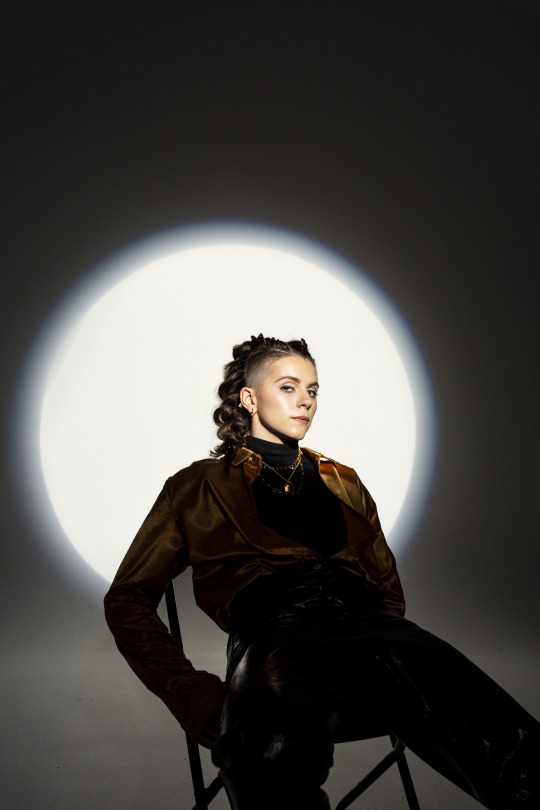
The saying goes “you can never really outrun yourself”, and from White Noise to Use Me, it seems that you’ve left a bit of a breadcrumb-trail leading us to this point. Although PVRIS has primarily been recognized as an Alternative Rock “band”, we can hear tiny glimpses of the sound that best encompasses PVRIS now throughout your entire discography. Was this glitch-pop, disco-esque sound something you were intentionally experimenting within your previous projects?
To be honest, this is always where I imagined PVRIS’s sound living and the type of production I’d heard PVRIS songs being told through. I think in the past I didn’t fully know how to communicate the little production nuances that would have taken some tracks from point A to B, there was also a fear (that I now regret having) about straying from the “rock” production/experiencing rejection from the “scene” we initially started playing shows and touring in.
For the most part, and I truly mean this, there really isn’t that much of a difference in the instrumentation and sonic choices of this album from the first two, it’s still a very even play of organic instruments and electronic/synths, it’s just being produced through a different lens that’s a bit cleaner, crisper and crunchier in some areas. It’s a new interpretation of the woodwork that’s always been there.
What has kept you motivated to continue creating and sharing your truth with the world?
That’s a great question because I go back and forth with that feeling sometimes… Ultimately seeing comments from fans/listeners and hearing everyone’s stories and ways that they connect to PVRIS’s music is the most motivating thing in the world. I also feel that no matter what type of obstacle course the universe wants to throw me through, I’m always going to be grateful for the bruises/lessons and always going to feel compelled to create and share those truths through music.
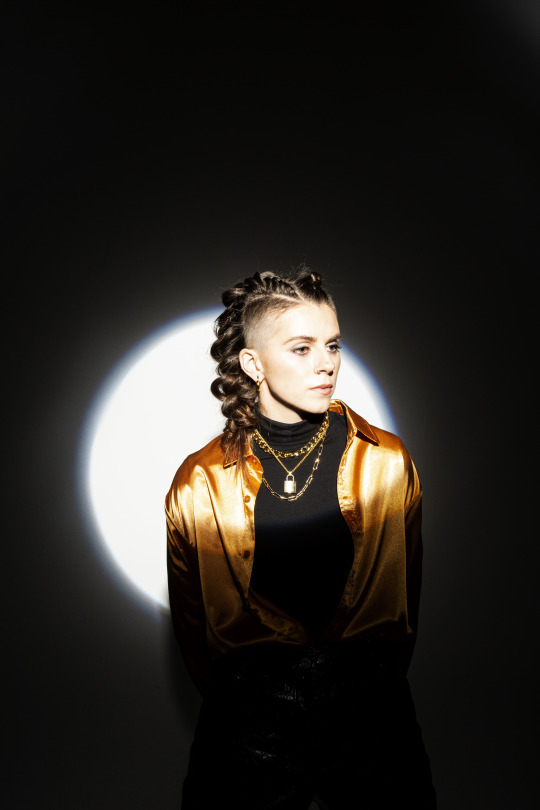
I understand you’ve run into a deluge of unfortunate health issues the past few years that have affected you and the band greatly. If you feel comfortable sharing, could you talk a little bit about these illnesses and the ways you have had to overcome the obstacles they brought forth to get you to where you are now?
Totally comfortable sharing! I was diagnosed with an autoimmune disease called Ankylosing Spondylitis (AS) about two years ago and then about a year ago was diagnosed with Crohn’s disease. AS is an inflammatory disease that mainly attacks the lower back, hips, and ribs, but it can also manifest in a lot of other ways as well such as joint pain, chronic fatigue, and even eye issues. Sometimes when my AS is really bad, I can barely get out of bed or even roll over in bed. Over time, if not treated properly or managed, it can cause your vertebrae to fuse... I’ve heard that’s super rare though. Crohn’s is chronic inflammation in the digestive tract and is a little more embarrassing but pretty self-explanatory haha…
They definitely taught me (and by taught I mean forced me) to take time in caring for myself and caring for my body. Resting properly, staying in shape, eating super healthy, setting boundaries with work, etc. It’s also just made me really appreciative of the moments when my symptoms aren’t as bad/just happy to be alive and not have it worse. I’m determined to manage both diseases holistically and through integrative medicine, so far I’ve seen great progress.
Do you believe these difficulties aided in your journey towards this self-actualization that listeners are able to distinguish in this new era of PVRIS? If so, how/in what way?
Definitely! There are definitely some references to those difficulties in a few of the songs. I think outside of the music, it’s given a lot more self-love, strength, and patience. It’s also just created even more urgency to live my truth and to live it unapologetically in the way that I want, which naturally extends into PVRIS and the art that I want to make.
youtube
If you had to use one word to describe each album thus far, what words would you use and why?
White Noise - Freshman - everything was so new and exciting and there was so much eagerness with it, like a freshman walking through a high school for the first time haha.
All We Know of Heaven, All We Need of Hell - Bootcamp (haha) - creating it and touring it were both pretty hard experiences BUT incredibly strengthening.
USE ME - Upgrade - despite all the chaos around this release, this is the freest I’ve felt and the most confident I’ve felt about a PVRIS album.
All the visuals and music video treatments that you have conjured up have a strikingly symbolic and cinematic feel to them. However, the symbolism and tone of the music videos tied to Use Me seem to take on a different nature. Can you talk about this shift in creative expression?
Mostly just working with new collaborators (Yhellow, Katharine White and Griffin Stoddard). I feel a lot less precious about things (to a healthy degree) and much more open to letting others run with the concepts as they wish! So many fun new exciting perspectives have been able to shine through.
I know you are a film fanatic and dabble in cinematography. Do you have any staple films that influenced the creation of the last five music videos?
The Holy Mountain was a big influence for the “Hallucinations” video, as well as [for] “Old Wounds”. For “Dead Weight”, I was actually inspired by the opening credits to That 70’s Show and Saturday Night Fever haha.

In July, you announced that the album was being pushed back so as to allow the floor for the amplification of Black voices, and to generate events in support of Black Lives Matter. Do you believe artists have a responsibility to take steps such as these to create a better future, regardless of whether or not these issues directly affect them?
Absolutely. We all need to be educating ourselves and actively doing the work to demand and create change towards a future that’s equal and just for Black lives.
Fans have been clinging to the edges of their proverbial seats waiting for Use Me in spite of all of the justifiable album delays. If you could relay one message to all the fans who have been patiently waiting, what would it be?
Please enjoy/connect, be good to each other and please please please vote if you are able!
Who are your Ones to Watch?
DRAMA, Jax Anderson, HDBeenDope, Royal and The Serpent, Nikki Hayes, Kat Cunning and LEXXE!
23 notes
·
View notes
Text
drumroll please...
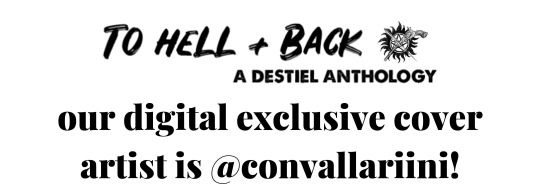

We’d like to give a special shout-out to @cas-watches-over-you, who was the first person to guess correctly (on our very first teaser post, no less!) that the wonderful @convallariini is going to be To Hell + Back Anthology’s Digital Exclusive cover artist ...great job!
If you’re not already following Maig, please go now! She’s a kind and truly lovely person, her art is seriously stunning, and we feel like she’s a bit of a hidden gem in the SPN fandom who deserves all the love for her creations. We can’t wait to see what beautiful work she dreams up for this project!
What is To Hell + Back?
Eight nerds. One television show. One city.
It was Dean and Cas who brought our team together and now we’re bringing you an anthology as an ode to the Supernatural family we’ve built. This anthology, inspired by homemade zines from fandom history, is not-for-profit, will be printed exclusively via crowd-funding raised by our fandom, and will feature fan creations made specifically for this project. Our group is passionate about transparency and diversity, and we will be broadcasting every step of our project on our social media to remain responsible and accountable throughout the anthology-making process.
Our group is composed of: @60r3d0m, @casthewise, @destimushi, @dusky-rambles, @justholdingstill, @naruhearts, @ravenscat-tumbler, and @thebloggerbloggerfun.
Who are you looking for?
Calling all short story writers, artists, comic creators, drabblers, poets and podficcers!
Our multimedia anthology comes in two parts: a print anthology and a digital exclusive! Our print anthology will showcase 33 collaborative writer-artist teams and our digital exclusive will feature 10 drabble writers, 10 poets, 20 artists, and as many podficcers as we can get! Together, these 106+ creators will form the heart and soul of To Hell + Back!
Interested in creating content for our anthology? No experience is required! You can find out more information on our Wiki as well as on our blog!
When can I sign up?
Sign-ups are open now and we have recently extended our application & sample submission deadline to October 12, 2019, at 11:59 PM PST. See the full schedule here.
Where can I sign up?
Apply to be part of the anthology here! Please note that there is a second part to the sign-up process where you will be asked to submit a small sample of your craft. This second link will be sent in a welcome email within 72 hours of signing up.
Where can I reach you if I have any questions?
In addition to Tumblr and the Wiki, we’re available on Twitter, Instagram, and via email at [email protected]! Please feel welcome to send us your questions and concerns via any of our channels of communication. We want to hear from you!
#tohellandbackanthology#fanthology#dean/castiel#destiel#cover artist#cover artist reveal#digital exclusive#spnfamily#spn fanart#spn fanfiction#convallariini#she is amazing and we love her#fanworks#fan project#jazz hands#signal boost!#can't wait to see what she creates!
176 notes
·
View notes
Photo
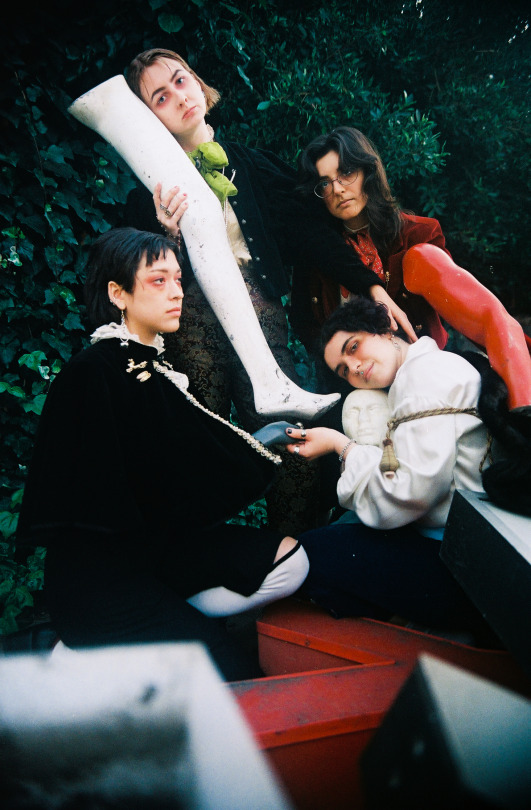
INTERVIEW: Girl Friday.
LA band Girl Friday's debut full-length Androgynous Mary will be out August 21 via Hardly Art.
Burning deep in Girl Friday's music is an unquenchable will to survive. The LA-based band don't blunt the impact of the themes they work through in their ferocious, knotty rock songs, but they don't let the more harrowing aspects of being alive and young in the 21st century daunt them, either. Taking full advantage of the dystopian shades of post-punk and noise rock palettes on their arresting debut LP, Androgynous Mary, Girl Friday nevertheless suffuse their music with abundant optimism. The world is a hellscape, but the four of them are in it together.
With bold, dramatic guitar lines and tightly wound vocal harmonies, Girl Friday negotiate the stress and alienation that comes with being sidelined from normative society on Androgynous Mary.
We had a chat with the band all about Androgynous Mary, the music industry and much more. Read the interview below.
Hi! How are you? How have you been spending your time during this pandemic? How has it affected you as a band?
Libby: "Hello! How are YOU? These days, generally diving into some long forgotten projects. I have been chipping away some music that may or may not ever emerge into the world."
Virginia: "I’ve been able to give some more time to working with other bands and collaborators which has been really nice. Outside of that, just using this time to reflect and learn."
Sierra: "Welcome to this interview. I am stocking up on metaphysical paraphernalia in the hopes that the spirits in my house will finally relent and participate in my long-awaited masquerade ball."
Vera: "Initially I was making tunes and learning Spanish and hanging with my family - now I’m always working but for the teachers union here in NZ so some important work and there is lots to learn."
You are gearing up to release your debut album Androgynous Mary in August. What can you tell us about the record?
Virginia: "In the words of the late Steve Irwin, “She’s a beauty!” I think we’re all very proud of dear Mary."
Sierra: "Mary likes to explore the entire emotional world at her disposal and say whatever she wants about it."
What were your musical influences for the LP? Who were you listening to around the time of writing it?
Libby: "The movie Hole."
Virginia: "Definitely second Hole. Pretty sure I had also started descending into my first Cheap Queen deep dive at the time."
Sierra: "I was photosynthesizing in a Placebo hole that I have yet to claw myself out of. And also a lot of Blaenavon. Every answer must include the word “hole.”"
Vera: "Holy moly mother Mary, literally holes what we dug and sat in."
Please talk us through your songwriting/creative process for Androgynous Mary.
Sierra: "On the third try, we successfully meet in the center of a dark room, under the disco ball. We scream in anguish into assorted jars and shake them violently until we can’t deny the brilliance of the sound contained therein."
What do you hope fans/listeners will take from the album?
Vera: "I just want people to be weird and feel ok about that."
Virginia: "I hope it’s as satisfying as eating a home cooked meal with your chosen family."
Sierra: "I hope they can listen to it on repeat for an extended period of time and feel like they are being held by a loving entity who is just as confused as they are."
Libby: "I hope they like me."

Were there any other songs written during this period that didn’t make it onto the album, and if so, will you revisit them again in the future?
Virginia: "Wouldn’t you like to know..."
Sierra: "We have a staggering and comical number of voice memos that, and I promise you will thank us for this, will likely never emerge from their technological encasings."
Libby: "Nah."
Which new artists/bands are you listening to right now? Anyone you think we should be checking out?
Libby: "Kills Birds, Ulrika Spacek."
Virginia: "Mod Pods, Suzie True, Cry Babe, Hot Moms, Genevieve Artadi."
Sierra: "Hayley Williams’s Petals for Armor. And my brother is about to release an album with our friend Brian that he’s put so much love and work into, and the entire universe needs to hear it! It’s called Silo by The Altogether. (Disclaimer: I am on it, but I can assure you I’ve contributed very little to its perfection)."
Vera: "At the moment I can only listen to this one album by Brian Eno and John Cale, Jesus is King by Kanye, Gracie Fields and Nina Simone."
If there was one thing you could change about the music world today, what would it be?
Libby: "More Trans A&Rs. More Black A&Rs, More POC A&Rs. More accountability in safe spaces."
Virginia: "More safe music venues open to minors!"
Sierra: "Fair pay for artists too."
Vera: "Agreed with all. And yes we really need the unionization of musicians and artists and understanding our value in society. Because it is labor and the fact we ‘love to do it’ is really exploited. Going off Libby's point, I think we need to acknowledge the major influence that music created and invented by BIPOC has had and continues to have in genres (including rock) where the main profiteers today are white men. We got to dismantle that."
What challenges, if any, have you faced in the music industry? And how did you overcome them?
Sierra: "We’ve been really lucky overall in terms of the people we’ve worked with, but we have gotten some not-so-sexy commentary from people assuming our genders and what that means about the music we’re able to make. We rename them all “Chris,” quietly hex them, and move on with our lives."
Finally, what do you have planned for when we're back to some sort of normality? I expect you're excited to get out on the road to tour the album following its release and when it is safe to do so?
Sierra: "You are absolutely right about that. Other than fantasizing about future tours, I’m taking it one day at a time."
Vera: "I don’t think there is a return to ‘normalcy’, but honestly if normalcy is Trumps America with a complacent public where cops intimidate and murder and money takes precedent over life, I don’t want to go back to that anyway. Let’s keep pushing forward."
youtube
Androgynous Mary is out August 21.
Photo credit: Al Kalyk
4 notes
·
View notes